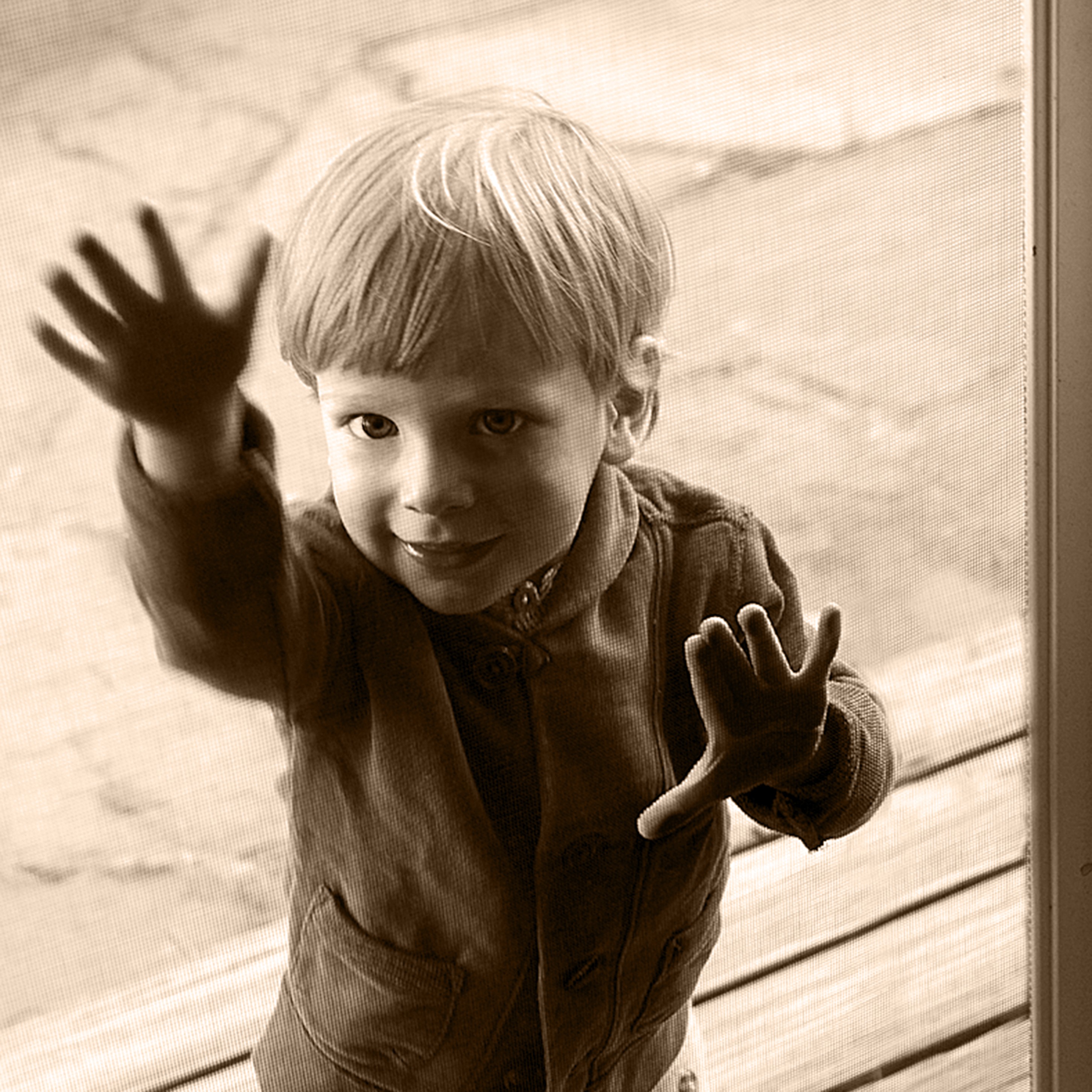Chapter 6: What's Your Style?
Classic and Romantic
Contemporary
Lifestyle Photography
Preparing Parents for Their Child’s Portrait
Portrait Planning
If you asked ten different photographers to photograph the same child in the same setting, you would have ten different interpretations of that same child. Just like the children you photograph, each photographer is unique in his or her view of the world. Some bring a fresh, hip perspective to their work with children, while others prefer to capture childhood in a more timeless, less trendy fashion.
What is your style? Do you have one yet? While most photographic work can’t simply be slotted into one category or another, it is helpful to make some broad generalizations when you’re starting out to give you a point of departure for your own work.
No matter what style of photography inspires you, it’s a good idea to try a little bit of everything when you start out. Learning to experiment with different locations and settings can give your inspiration a boost. This chapter shows you some ways to expand your skills and try some new styles.
Start an idea file or bulletin board of photos that you’ve clipped from magazines and/or bookmark your favorite websites that show photography that inspires you. As your skill level increases, these references give you inspiration for your own work.
Classic and Romantic
Many parents appreciate portraits that reveal a sense of timelessness. The classic style of child photography has its roots in the paintings of the old masters. Drawing on the style of painters such as Rembrandt, Vermeer, and others, the classic and romantic style of children’s portraiture can often be seen as an idealized version of childhood.
In the studio
When shooting in the studio, a classic portrait becomes a study of the child you are photographing. There are no distracting elements to take your attention away from the child, leaving only their expressions and gestures to tell the story. In many ways, capturing a storytelling image in the studio can be much more challenging than shooting on location, where you can rely on the environment to render part of the story.
In a photograph that is low key, the background is darker and perhaps more colorful, as it would be in a garden or forest. If the clothing is darker as well, your attention again is drawn to the skin tones, or the lightest thing in the photograph, as in 6-1. Classic and romantic styles work well with painted muslin or canvas backgrounds that give a painterly feel to the image.
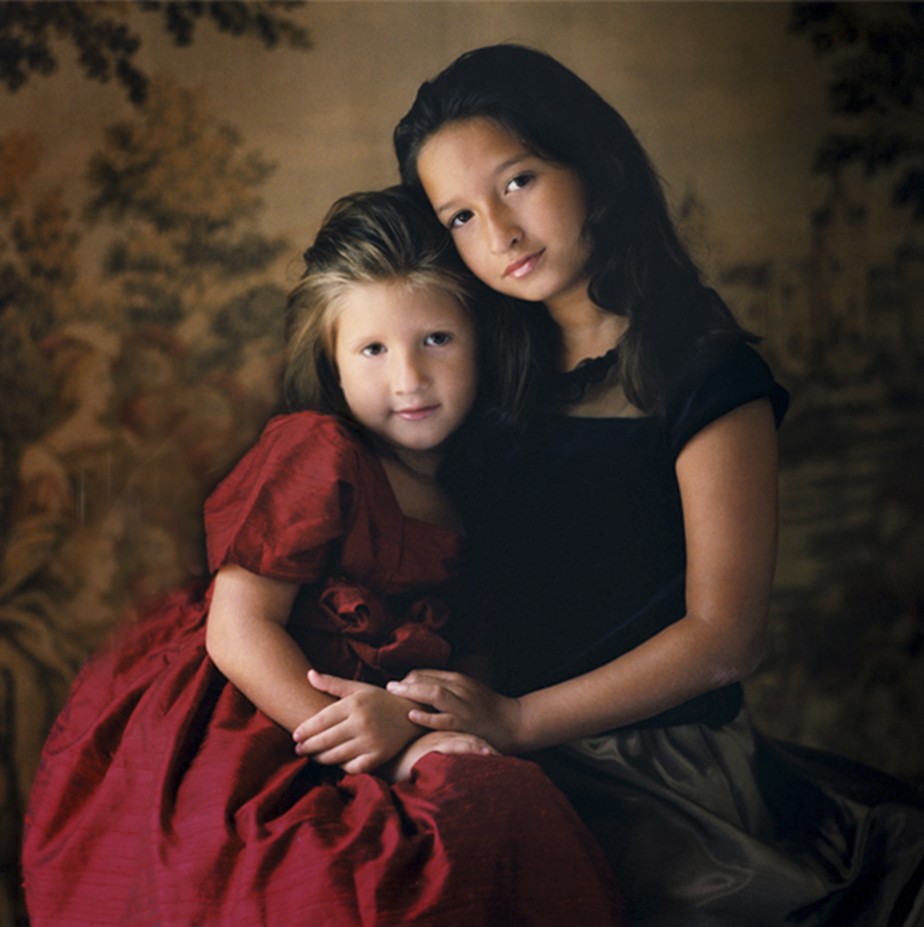
6-1
ABOUT THIS PHOTO A classical portrait of two sisters was captured in the window light in front of a painted backdrop. The tones of the dresses and the background make a lowkey image. Taken at ISO 400, f/4.0, and 1/30 second. ©Lizbeth Guerrina / www.paulineandlizbethphotography.com
A simple chair and pillow and window light can provide all you need for a portrait, without any worry about wall backdrops (see 6-2). Just be sure to crop in close and avoid any clutter in the background.
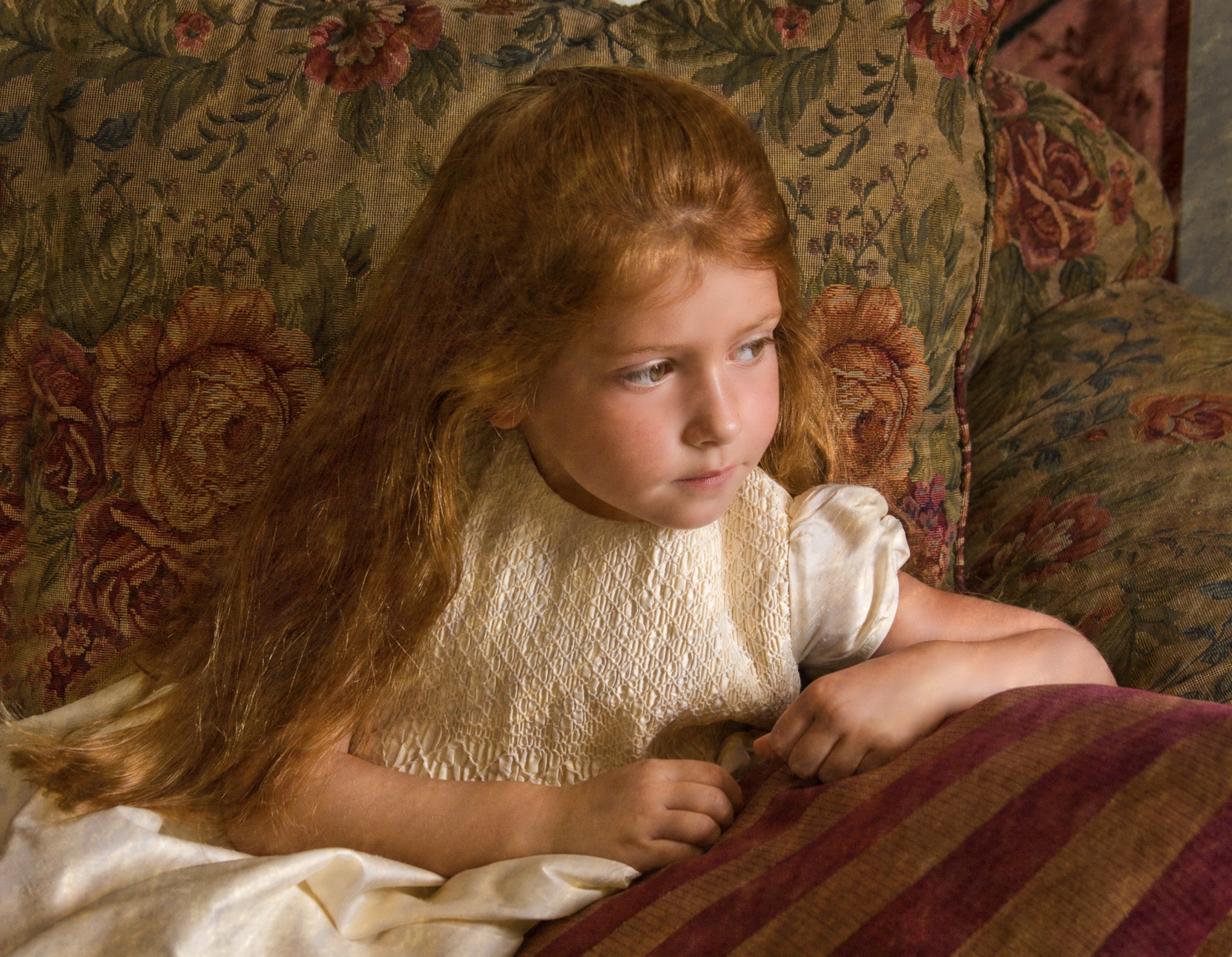
6-2
ABOUT THIS PHOTO The timeless tapestry on the chair harmonizes with the coloring of this little girl, enhanced by soft window light. Taken at ISO 640, f/5.6, and 1/60 second. ©Theresa Smerud / www.theresasmerud.com
On location
For classic and romantic portrait styles, seek soft light and a quiet, peaceful location, as in 6-3.
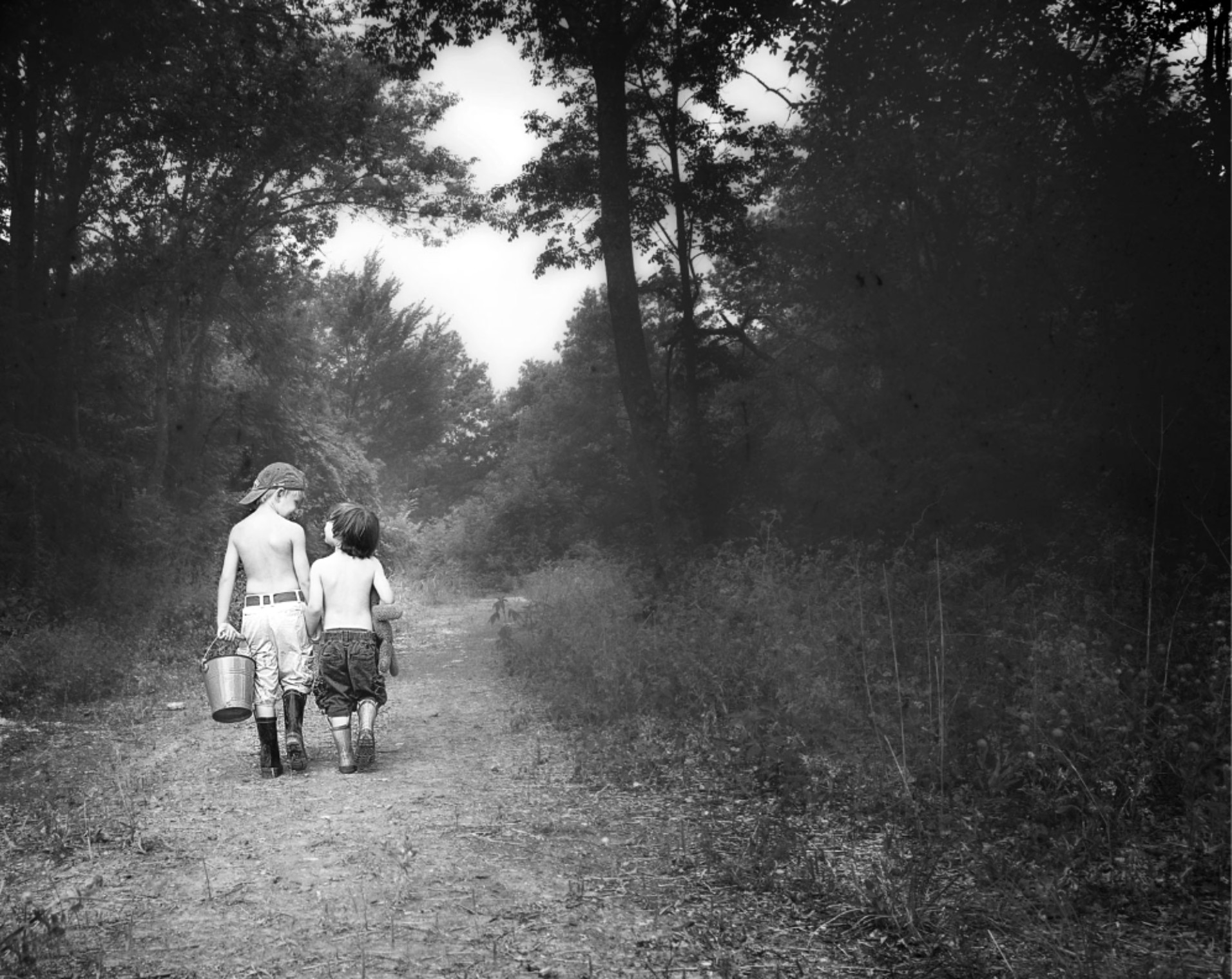
6-3
ABOUT THIS PHOTO The soft and diffused light on the edge of the forest created a timeless and romantic look to this portrait. Taken at ISO 600, f/6.3, and 1/200 second. ©Mary Schannen / www.melangephoto.com
When children are quiet and wistful, their eyes are often open wide, and their cheeks are soft and full. On the other hand, never let a spontaneous, energetic, or spunky moment, as in 6-4, go unphotographed. Capturing these moments on location allows you to tell a more layered, romantic story.
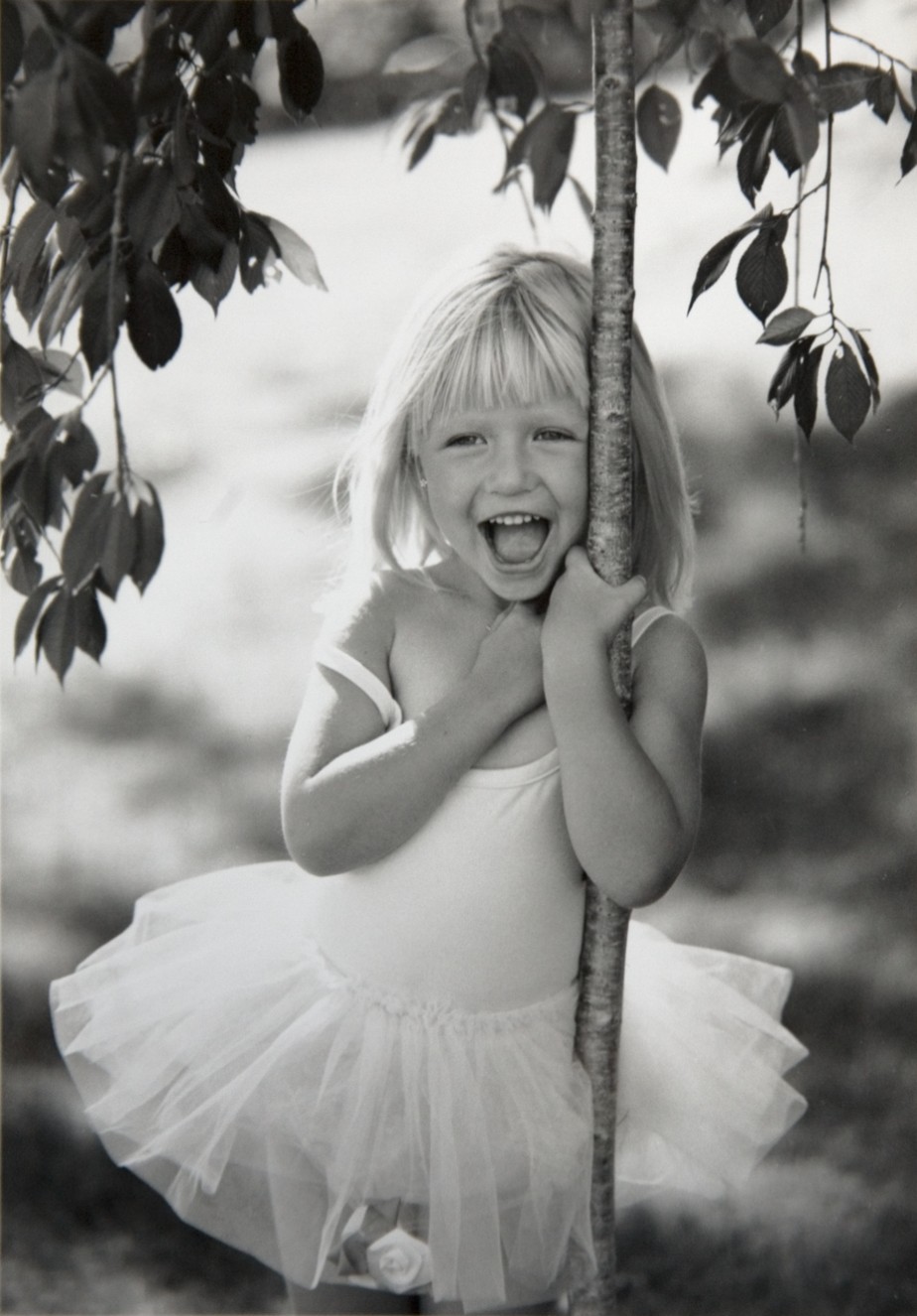
6-4
ABOUT THIS PHOTO Does it get any better than wearing your tutu on a summer day? This expression begs otherwise! The backlighting and framing by the foliage add to what is already a beautiful image. Taken at ISO 320, f/4.0, and 1/125 second. ©Patrisha McLean / www.patrishamclean.com
Photographing on the family’s property or at a favorite place adds meaning to the photograph that just isn’t possible in a studio environment.
Talk to parents about your desire to work in the best and most dramatic lighting situations you can find, as in 6-5. Usually they aren’t as aware as you are of what that actually means, so you need to help them understand so they are cooperative. You are the professional, and they should look to you for guidance.

6-5
ABOUT THIS PHOTO The graceful little dancer practices her moves as the setting sun adds a moody backlight. Taken at ISO 100, f/1.8, and1/160 second. ©Andrea Joki / www.ajatonjoki.com
As you now know, choosing the best location is dependent on high-quality available light. You can’t always count on the very best, but you can surely try. Let parents know that late afternoons, when the sun is at an angle, provide beautiful and luminous warm light. Foggy days work really well at the beach.
Visit the location ahead of time to see what you can expect the day of the session. Maybe the parents can go along with you to see what you are looking for and, thus, further collaborate to make a better portrait. Whatever it is you personally want to convey, share it with the parents so you all are in accord with what is going to be created.
In almost every major metropolitan area there are botanical and historical gardens and parks. These are good places if you live in an urban area and want to add the feel of nature in your work. Don’t overlook buildings or areas with classic architecture to enhance your images. If you live in rural areas, meadows, orchards, and fields are at your disposal. Take advantage! If you are lucky enough to live near the ocean, beaches are a lovely place to photograph children.
The Key of Light
Just as music is played in different keys, light can also be keyed to the mood you want to portray. A great deal of latitude exists in-between these examples, but they demonstrate an important point: The faces, eyes, and skin tones of the child are emphasized by choosing clothing and surroundings that suit the mood of the portrait envisioned by the photographer. Parents might have a preference for one style over another, so it helps to show them photographs you have made beforehand that demonstrate the following styles.
A low-key portrait is one in which the tones of the image are predominantly dark (or low), leaving the skin tones of your subject as the lightest parts of the image. Typically high in contrast, a low-key image can be very dramatic and moody.
A high-key portrait is predominantly light in tone with the skin tones being the darkest parts of the image, allowing them to stand out. Usually low in contrast, a high-key image can be ethereal and romantic.
Clothing
For a classic portrait, you want the clothing to be as timeless and traditional as possible. Distracting logos, plaids, and large stripes can often distract from the child. Solid colors and timeless clothing designs such as white dresses for girls and button-down shirts and jeans for boys leave the emphasis on the child. Avoid huge hair bows and uncomfortable clothing for babies. Babies are often best photographed au naturel (with no clothes at all)!
Watch out for shoes as well. Nothing dates a photo faster than ever-changing shoe styles, so when in doubt, have your subjects go barefoot. Children’s feet are usually so perfectly round and sweet, but be sure to get the parents’ permission first!
In 6-6 you can see that the siblings are dressed in light-colored vintage clothing to add to the timelessness of this photograph. All the decisions in light, composition, and clothing were intentional to create a timeless, enduring photograph.
“When the first baby laughed for the first time, the laugh broke into a thousand pieces, and they all went skipping about, and that was the beginning of the fairies.” ~Sir James M. Barrie, in Peter Pan
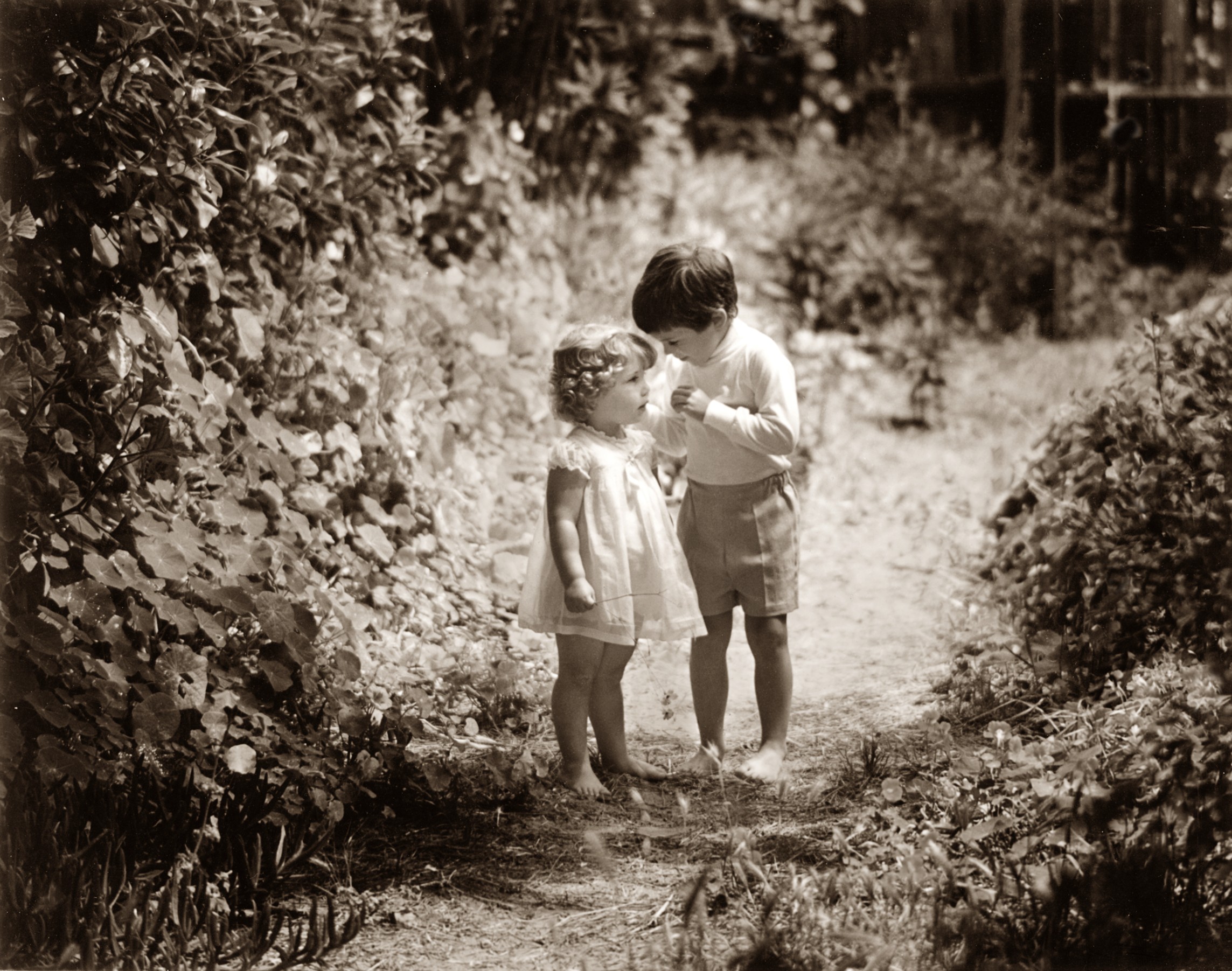
6-6
ABOUT THIS PHOTO I was probably unconsciously inspired by W. Eugene Smith’s photograph “The Walk to Paradise Garden” (1946) when I photographed these cherubs in a nasturtium patch by the beach. The vintage clothing and the vignette of the foliage added aptly to the composition. Taken with film at ISO 160, f/5.6, and 1/100 second. ©Ginny Felch / www.photographingchildren.com
Clothing should not overwhelm or distract from your subject. In both 6-7 and 6-8 you pay attention to the children, not so much their clothing. If either had been wearing a T-shirt with a big logo or stripes, these images would have had a completely different look.
All the decisions you make, whether it’s the location, the lighting, or the clothing you’ve selected, add or detract from the mood you are trying to convey. Deciding ahead of time what mood you would like to convey in your image is the key.
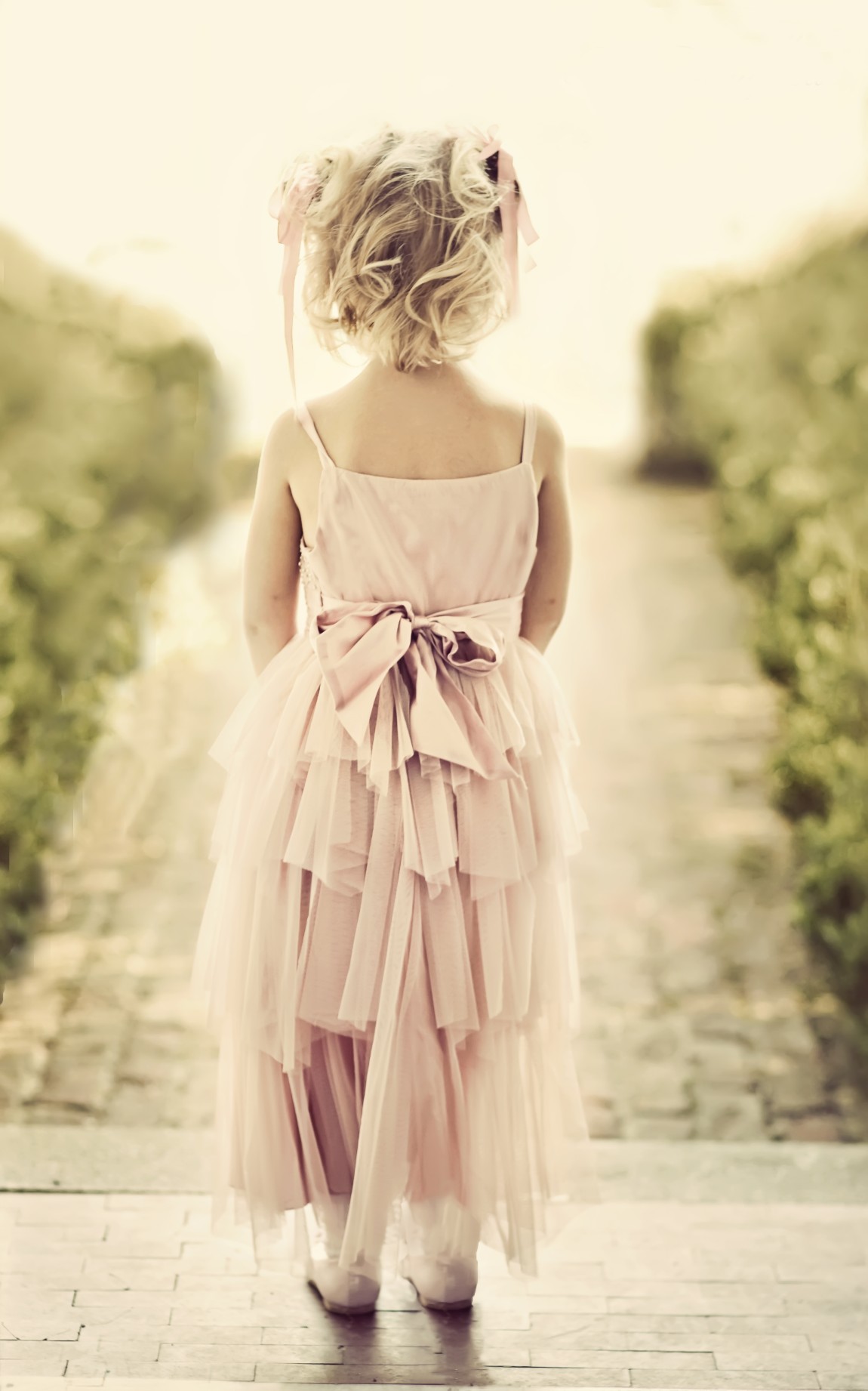
6-7
ABOUT THIS PHOTO The clothing for a ballet performance inspired the photographer to make use of lovely window light to compose this painterly portrait. The subdued yet vintage clothing could be right off of a movie set; the pastels and the composition draw us in to the possible stories. Taken at ISO 200, f/2.0, and 1/160 second. ©Abi Campbell / www.abicampbellphotography.com
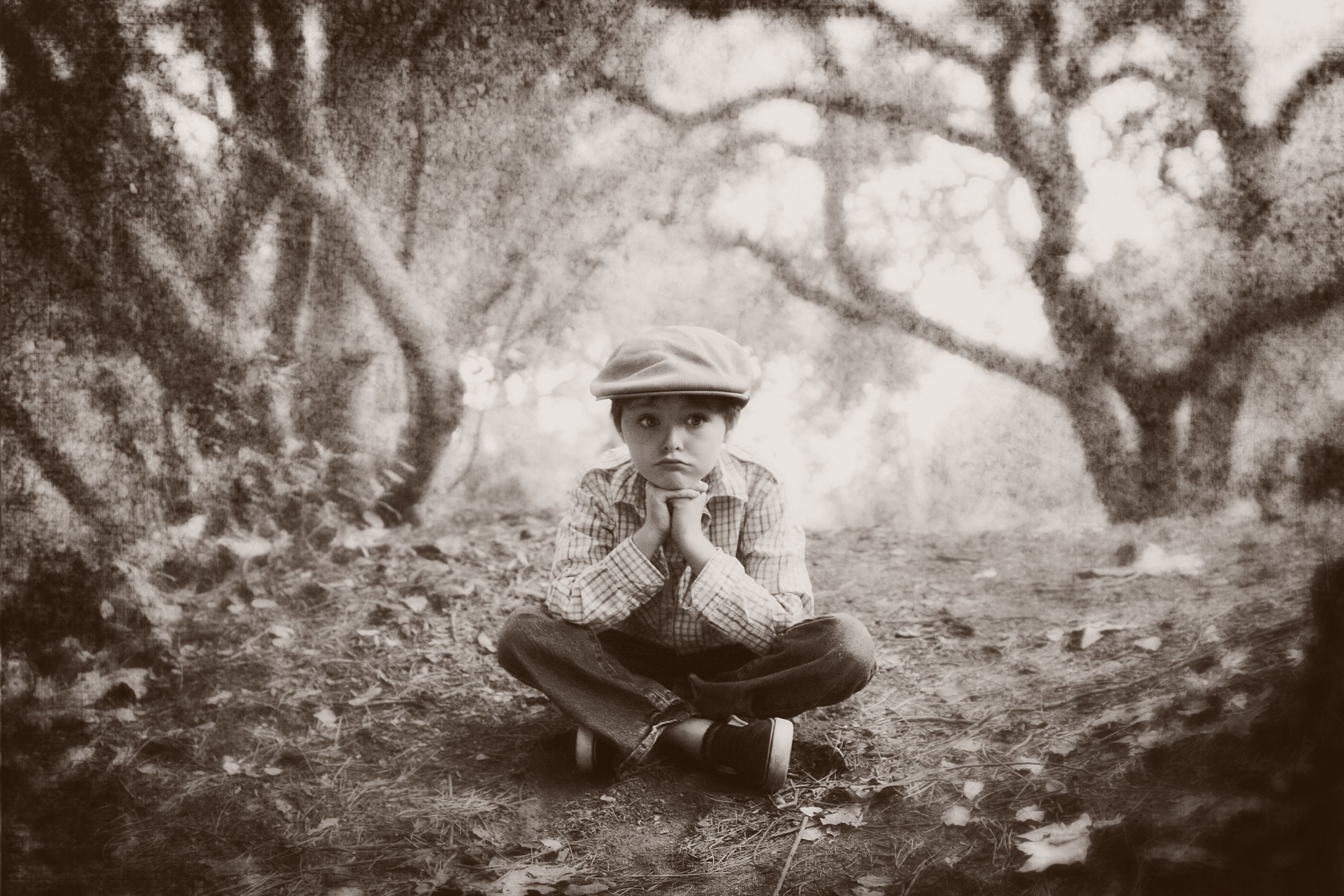
6-8
ABOUT THIS PHOTO Using texture and a straightforward classical composition, this masterly and moody portrait of a boy in the woods evolved. Taken at ISO 800, f/ 2.8, and 1/125 second. ©Jessica Drossin / www.jessicadrossinphotography.com
General Clothing Guidelines
Parents need to know that the whole idea of fussing about clothing serves but one purpose: The focus should be on the child’s beautiful, soft face, not the clothing. That is why it’s important to have certain guidelines about clothing, which, when followed by parents, result in great photos. Regardless of your style, the general guidelines here should serve you well.
• Suggest parents avoid bold stripes, plaids or prints, insignias, logos, and so on. Textures work beautifully in sweaters, just in case it’s chilly, but be careful that the texture isn’t overpowering.
• Have tools handy to fix a child’s hair. Ask parents to tell you ahead of time what they do and don’t like. You can simply carry a little bottle of spray water and another of light hairspray. You don’t want to be in a situation where you have taken a series of great photographs and find out later that mom dislikes her daughter’s hair pulled back, or some such disaster.
• If a child has braces, tell parents not to worry. Braces are a rite of passage, and most people will look back with smiles as they remember those times. However, if parents wish, you can decrease the brashness of the metal or even completely remove them in post-production.
What are you trying to convey about this child and her personality? What elements in the surrounding environment can you use to support your vision? Do you want an image full of energy and whimsy or is the child more thoughtful and shy?
For example, the soft, contouring light that surrounds this young girl’s peaceful countenance in 6-9 causes the viewer to ponder what she might have been thinking when this photo was captured. The mood is serene and thoughtful.
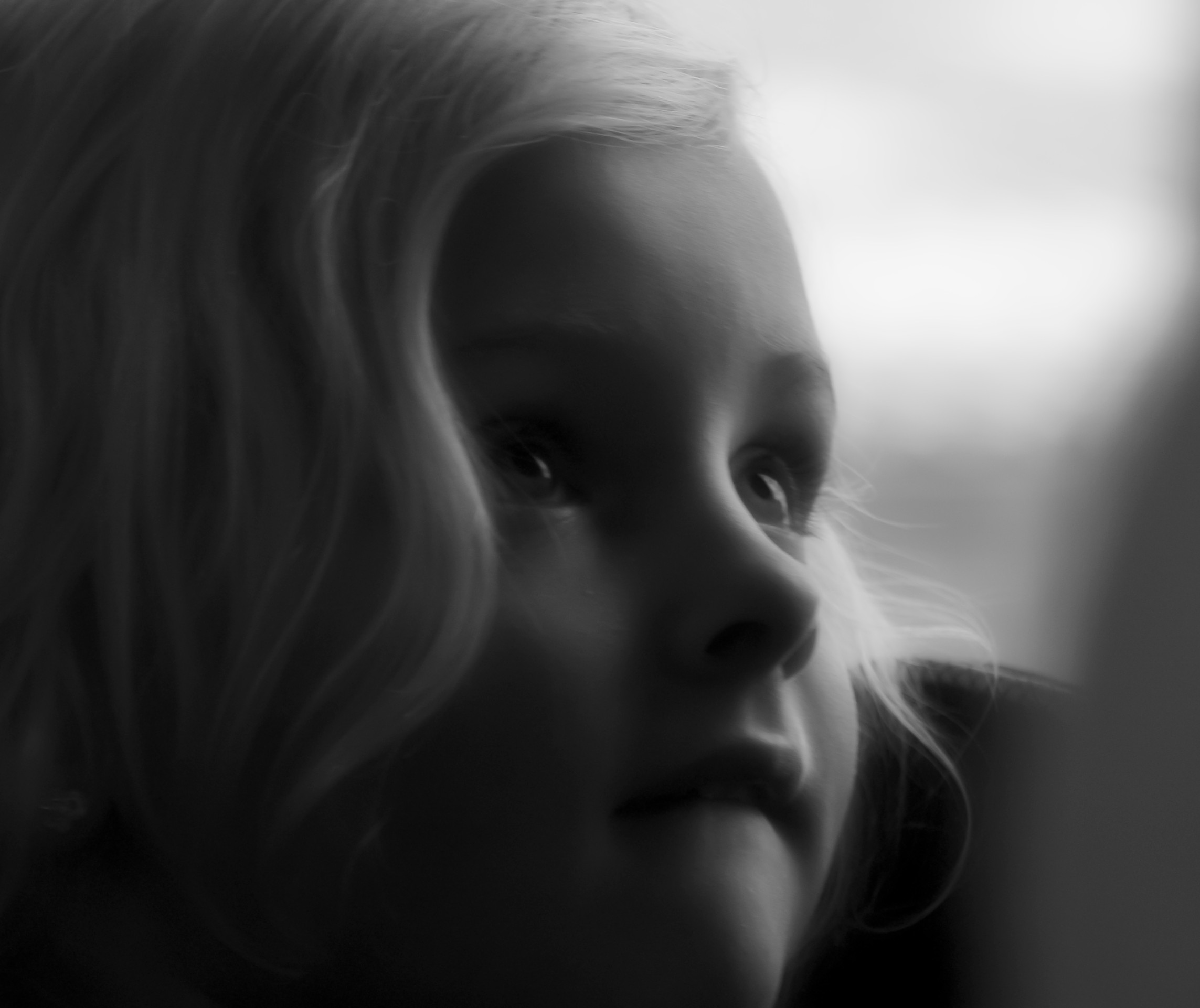
6-9
ABOUT THIS PHOTO The photographer just let this little girl be herself, which resulted in a beguiling expression rather than a phony smile. Beautifully orchestrated, this style is reminiscent of Hurrell’s dramatic style. Taken at ISO 200, f/6.3, and 1/40 second. ©Michel Franck / www.flickr.com/photos/sw127350/
A tranquil, otherworldly feeling permeates the image of a little explorer at the beach in 6-10. An entirely different mood would have been captured had she been dressed in contemporary colorful clothing. Her gesture with the walking stick suggests that something as formal as a white dress would hardly have been appropriate for this session.
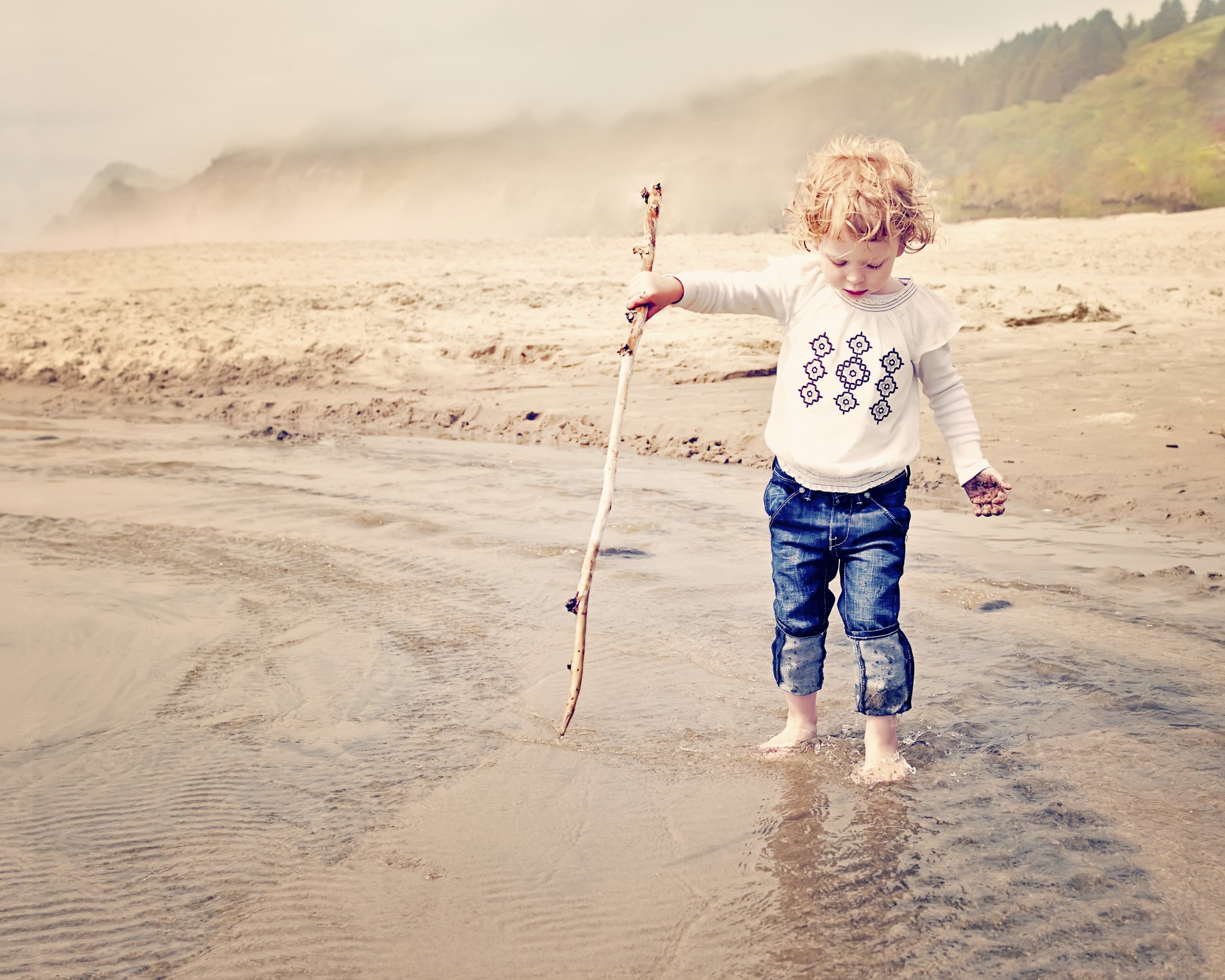
6-10
ABOUT THIS PHOTO This modern, yet classic portrait of a strawberry-blonde adventurer was composed thoughtfully in a C-curve for emphasis. The photographer used her own actions in post-production. Taken at ISO 200, f/4.5, and 1/1250 second. ©Annie Manning / www.paintthemoon.net
Contemporary
Contemporary children’s portraiture is whatever is trendy and cool at the moment, but even within current trends there is often a strong thread of timelessness. A contemporary style tends to break with tradition. Instead of stylized posing, the idea is to encourage the real, often more animated, personality of the child to come to the forefront. Cropped-off heads and full-out belly laughs are just right for this style of portraiture.
In the studio
Studio photography lends itself very well to contemporary portraiture, as much of this style is inspired by magazine advertising. Seamless paper backgrounds work well for a contemporary feel. Inexpensive and available in a wide variety of colors, seamless backgrounds can give you many background choices for much less money than canvas or muslin backdrops.
When attempting a contemporary style in the studio, the idea is to set up the lighting so that a fairly wide area is well lit, allowing the subject a bit of room to move around. As in the photo of two sisters in 6-11, the background doesn’t compete for attention, and a fan blows their hair, giving movement to the image.
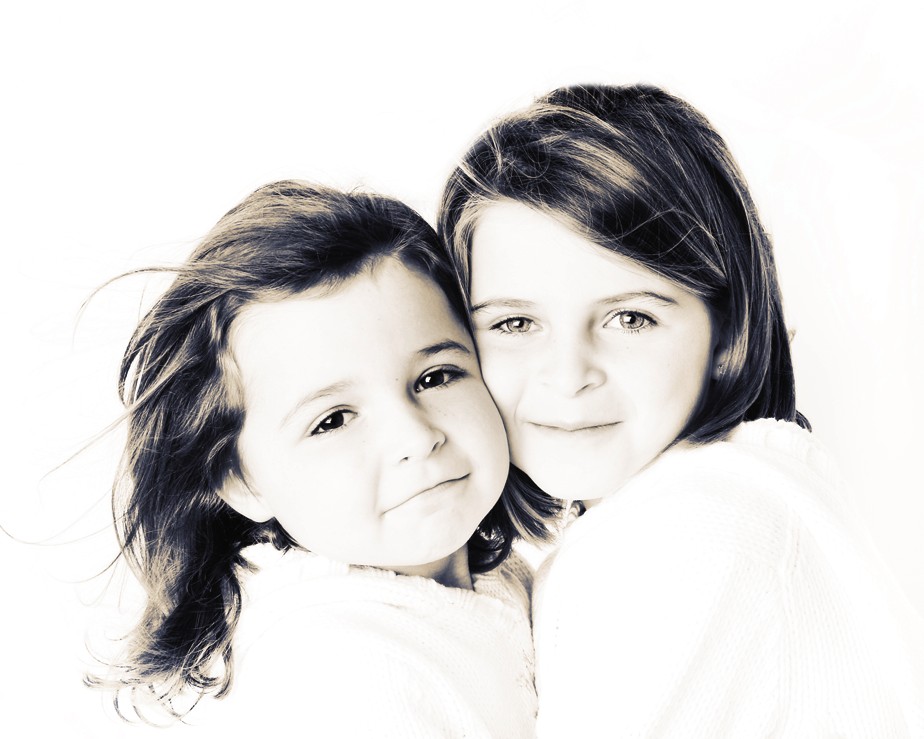
6-11
ABOUT THIS PHOTO A more contemporary treatment of a sisters’ portrait utilizes a white background and fan to provide movement in their hair. Taken at ISO 100, f/2, 2.8, and 1/125 second. ©Jeffrey Woods / www.jwportraitlife.com
Sometimes, extreme cropping can give an edgy, contemporary feel to your images. The images in 6-12 and 6-13 both take advantage of negative space, allowing all the focus to fall on the subject. Who says your subject’s head has to be in the photo? In 6-13 you get a good sense of these little boys without ever seeing their faces.

6-12
ABOUT THIS PHOTO The photographer placed this little girl in the far right of the frame, which adds to the contemporary feel of the image. Taken at ISO 100, f/3.5, and 1/125 second. ©Jeffrey Woods / www.jwportraitlife.com
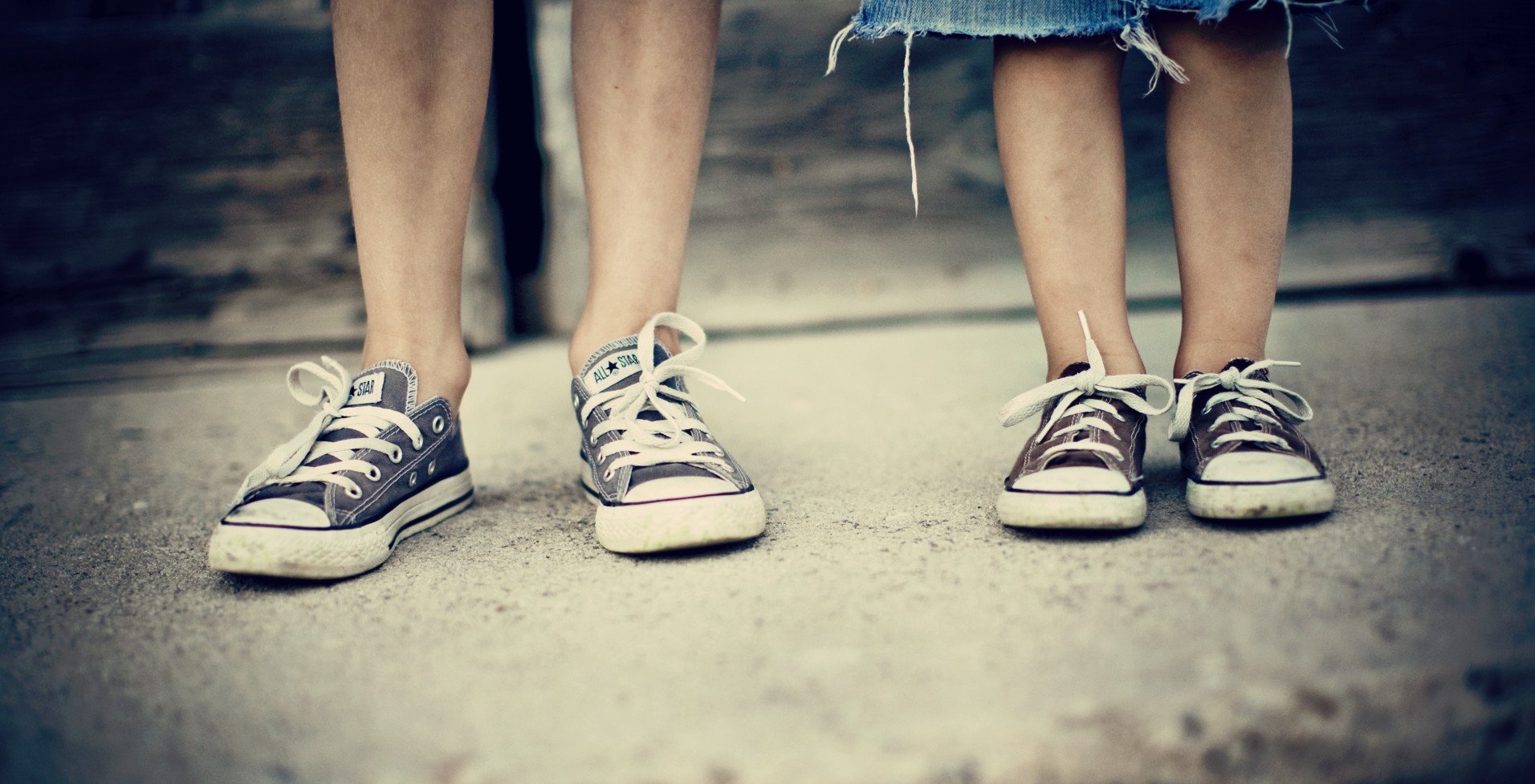
6-13
ABOUT THIS PHOTO The sneakers, bruised legs, and cut-offs tell you just as much about these boys as seeing their faces would. Taken at ISO 400, f/1.6, and 1/400 second. ©Cama Cathrae / www.camacathrae.com
Sometimes contemporary style consists of turning the traditional style on its head, as in 6-14. The lighting and background just scream classic and romantic. But a topless baby in a pair of jeans with a (Photoshopped, of course) tattoo on his chest is anything but traditional.
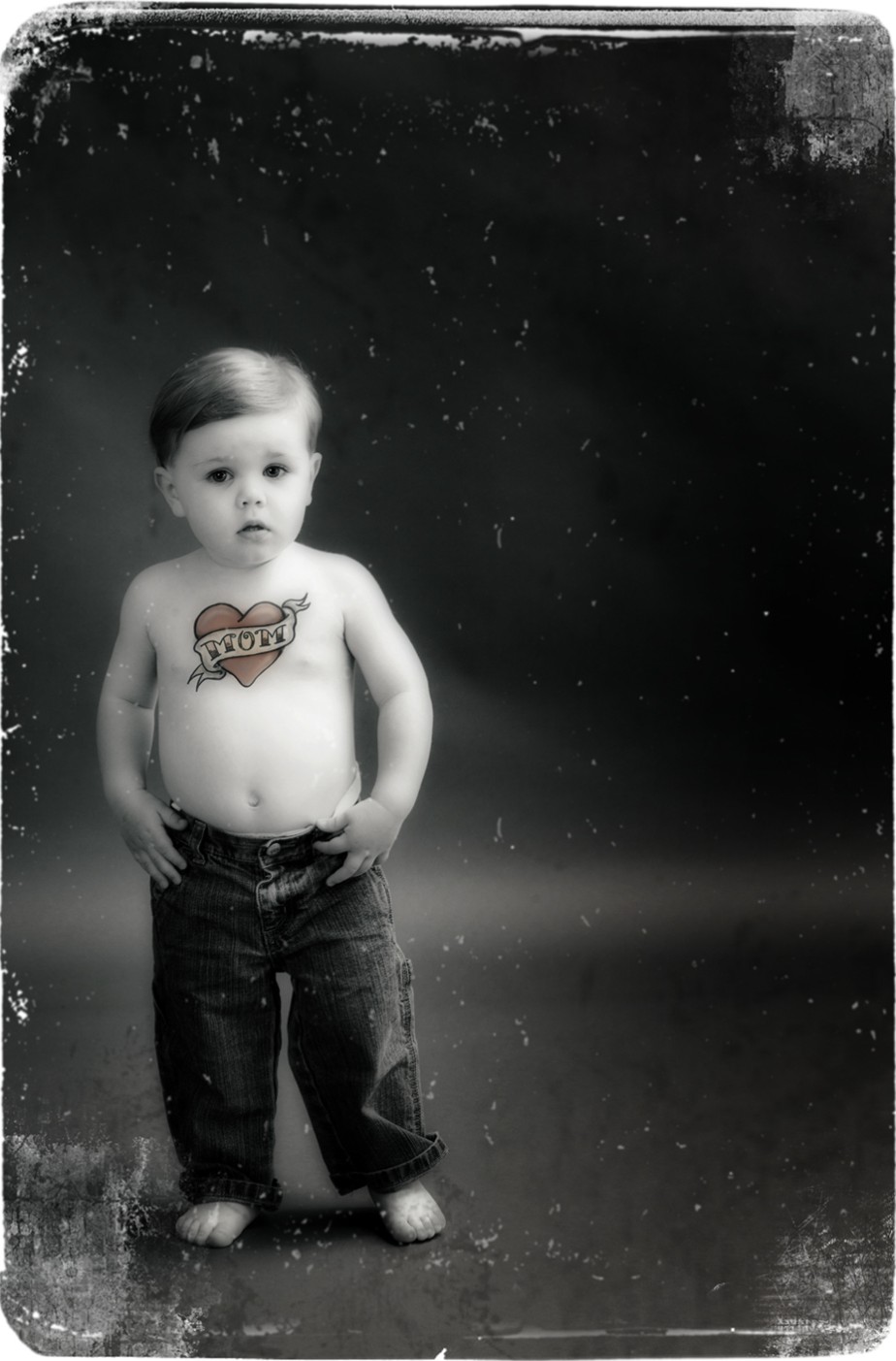
6-14
ABOUT THIS PHOTO The background and lighting are traditional, but the pose and treatment are anything but. Taken at ISO 125, f/7.1, and 1/125 second. ©Jeffrey Woods / www.jwportraitlife.com
In this day of media saturation, we are much more image savvy than ever. Ads on television, in magazines, and on the Internet all influence our taste and style. This girl in 6-15 is very young, but that doesn’t prevent her from wanting to look like a super model and express some attitude!

6-15
ABOUT THIS PHOTO The interaction between the photographer and this sassy and adorable little girl, along with the minimalist setting, just screams out contemporary. Taken at ISO 200, f/9.0, and 1/250 second. ©Allison Tyler Jones / www.atjphoto.com
Traditional family portraits rely on careful posing and arrangement of each family member. A contemporary style seeks to get a little closer to reality by allowing the family members to pose themselves and interact with each other in a more natural way, as in 6-16.
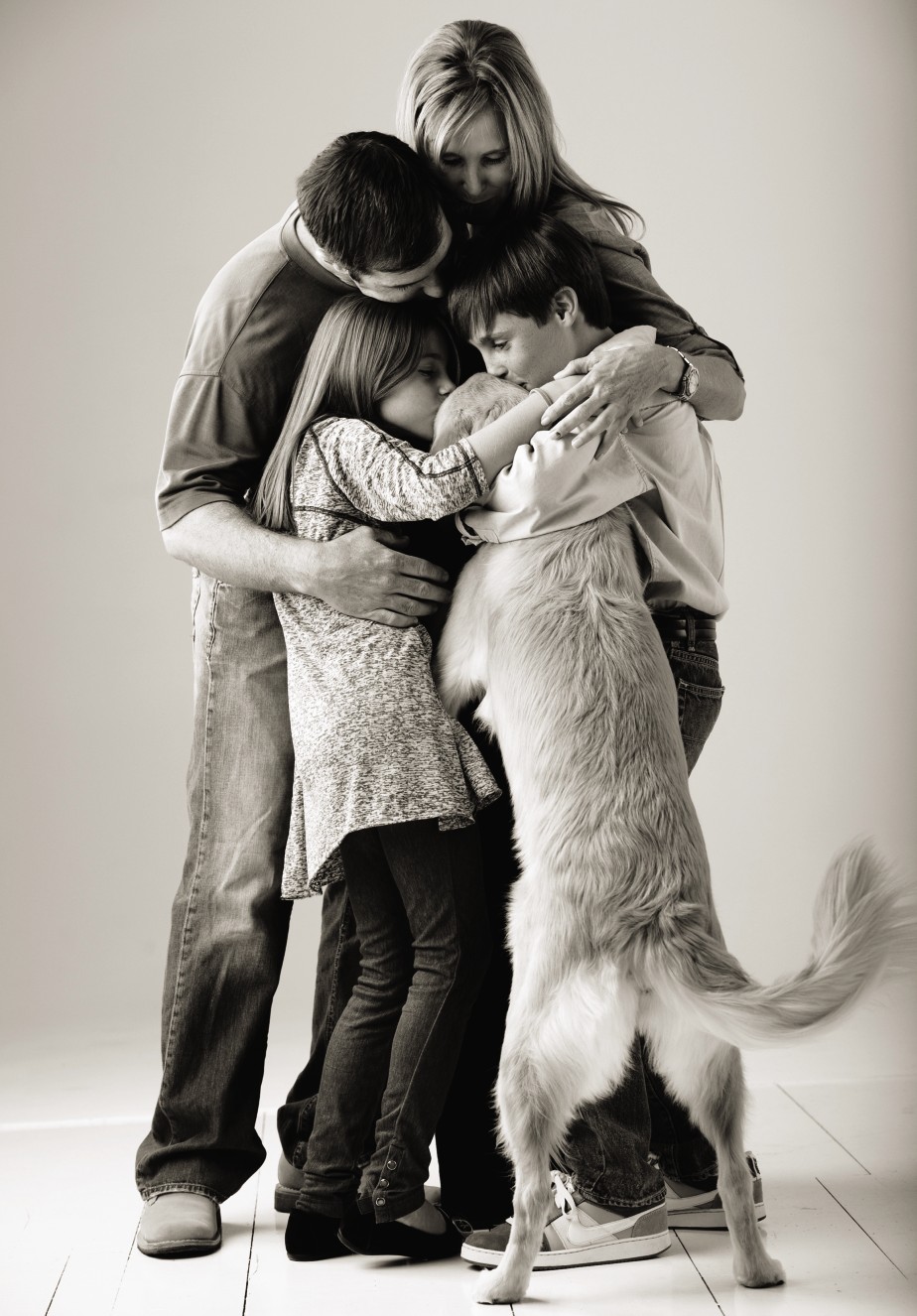
6-16
ABOUT THIS PHOTO Inviting the family pooch on the set will always liven up a photo session, and the connection of this family is palpable. Taken at ISO 200, f/5.6, and 1/250 second. ©Allison Tyler Jones / www.atjphoto.com
On location
Any location can work for a contemporary style because the style depends on how the photographer sees the subject more than on the actual location itself. However, you may want to look through this section for ideas on similar locations in your town. As you look through them, you may see how each location could be used in a classic and romantic or a contemporary or photojournalistic way. It all depends on your point of view.
Urban decay is part of the world we live in, and contemporary portraiture is geared to take full advantage of what some might see as old and ugly. An old industrial door adds texture and interest to the background in the image of the young girl in 6-17.
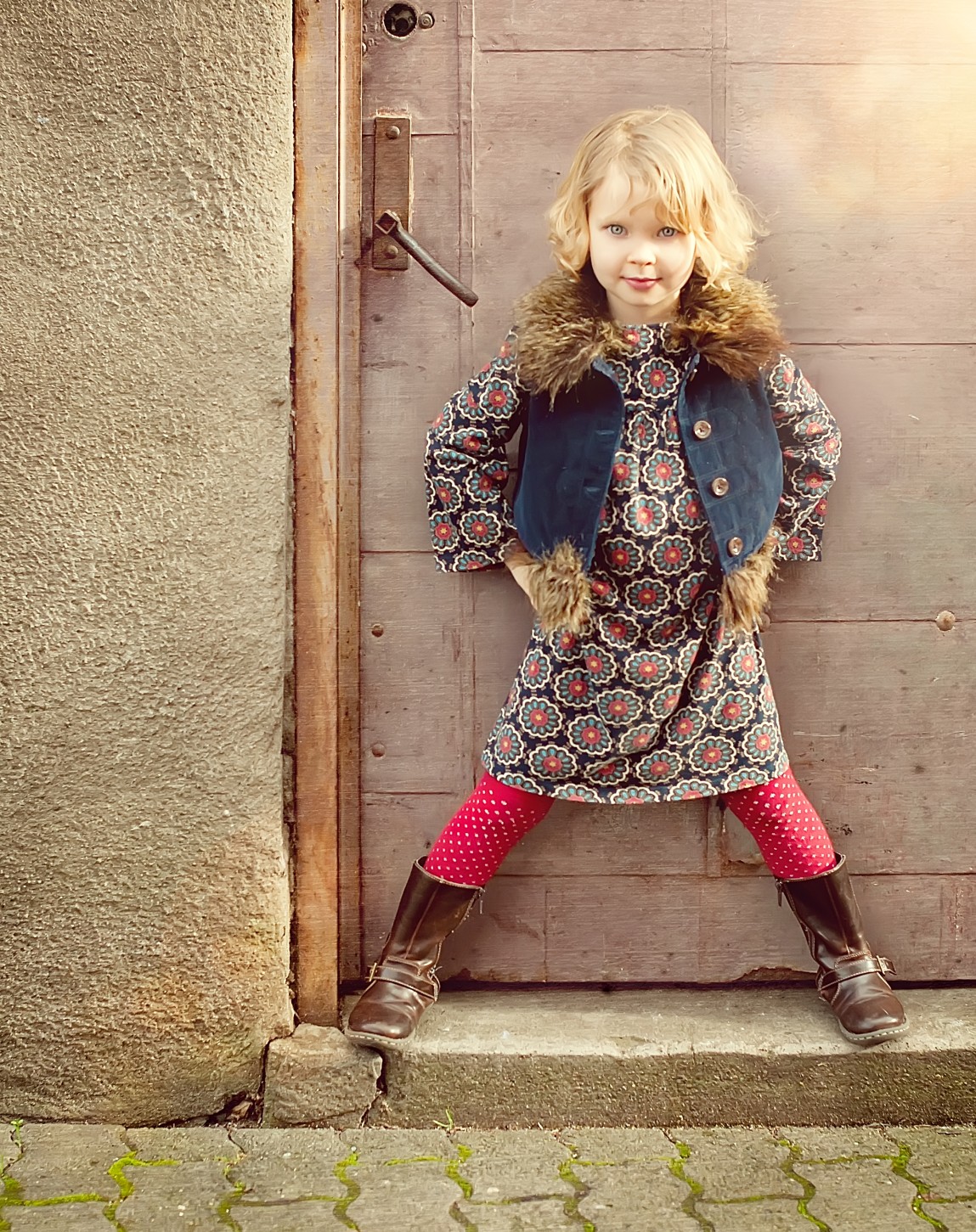
6-17
ABOUT THIS PHOTO The old farm door and stucco wall add texture and interest to the background while the girl’s confident expression conveys her personality. The photographer used her own actions and textures in post-production. Taken at ISO 400, f/2.8, and 1/640 second. ©Annie Manning / www.paintthemoon.net
“The portrait photographer who understands his work will never seek a formula for success. Those who would simplify portraiture to a few rules and diagrams will serve you pretty cold potatoes, for the vital essence of the good portrait is too elusive to be caught and bottled. Portraiture will always be an art of discovery.” ~Edward Weston
A wall mural acts as an interesting and amusing background for the stylish baby in 6-18. However, kids often just aren’t into the “cutesy” that their moms still love. They are just as influenced by images as their parents and they want to look cool. In 6-19 for example, the vibrant blue building acts as a video-like set for this group of friends while the subtle backlight separates them from the background.
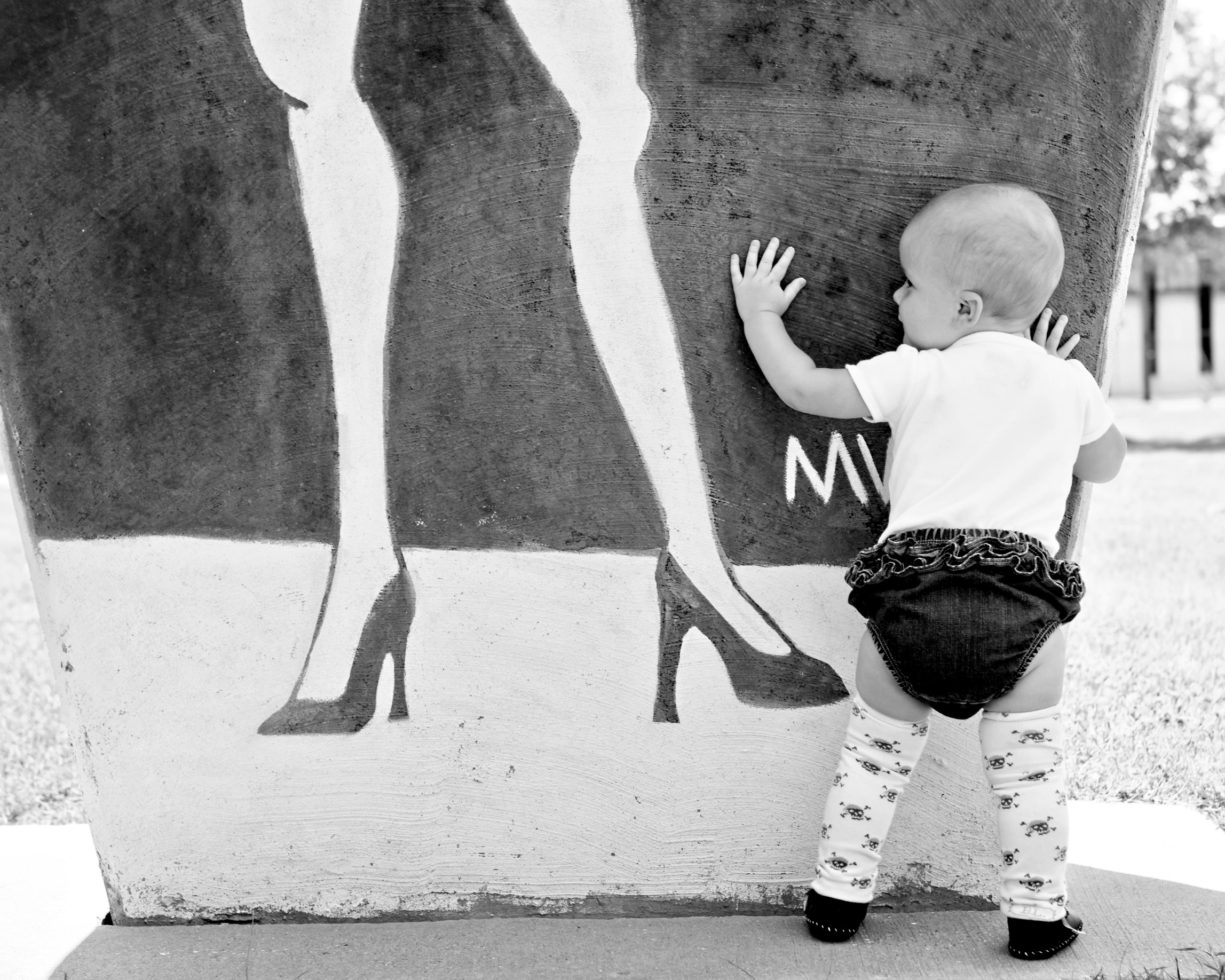
6-18
ABOUT THIS PHOTO The keen and observing eye of the photographer caught the irony of the fashionable baby in front of a very grown-up poster. Taken at ISO 100, f/5.0, and 1/200 second. ©Melanie Johnson / www.melaniejohnson.com
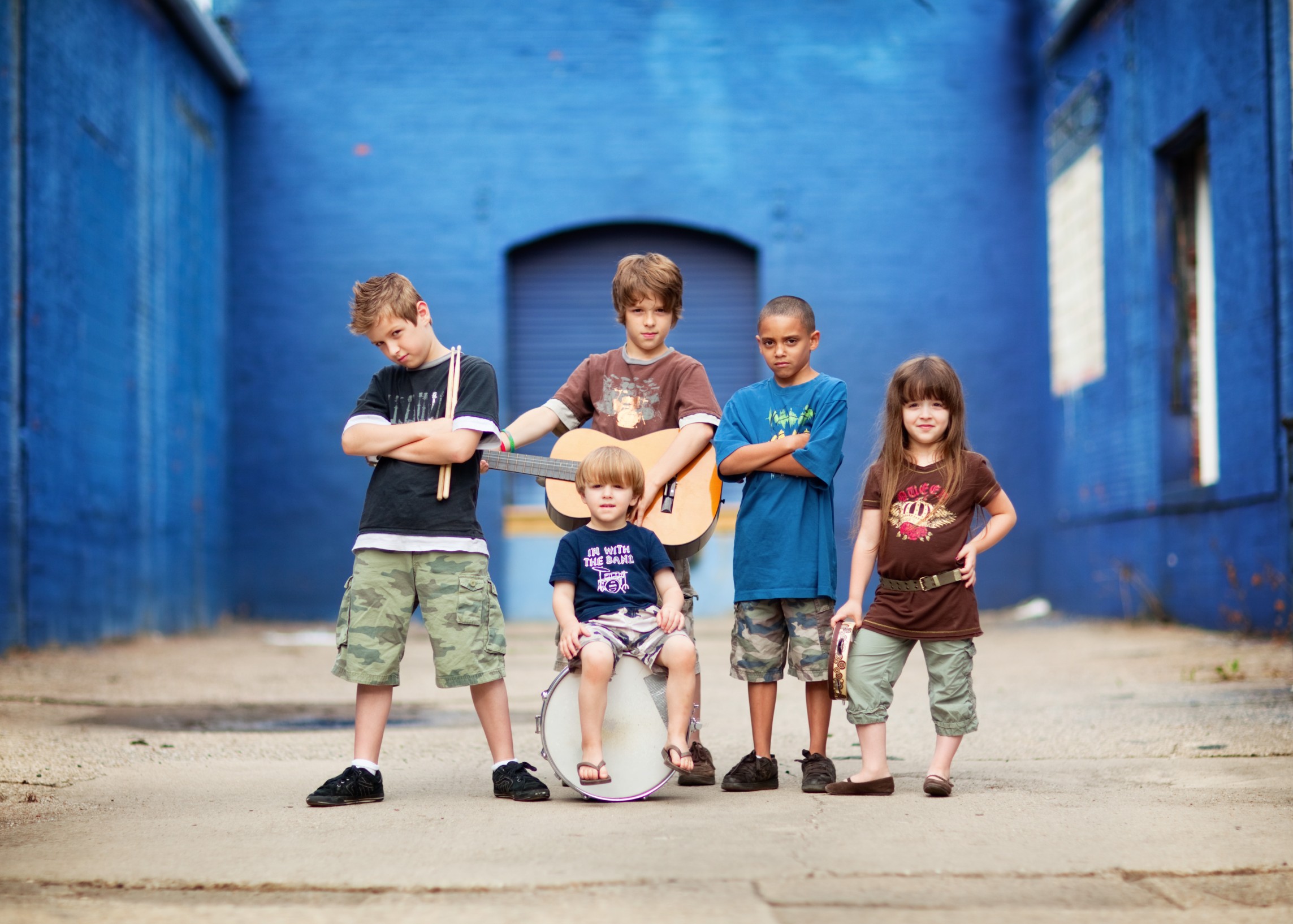
6-19
ABOUT THIS PHOTO Surely the photographer and performing kids were influenced by contemporary media. Taken at ISO 100, f/1.6, and 1/1000 second. ©Leah Profancik / www.leahprofanicik.com
Libraries, art centers, and other public buildings (even parking garages) can be great places to capture children and their families. Use the lines in the architecture to frame your subjects or draw attention to them, as in 6-20.
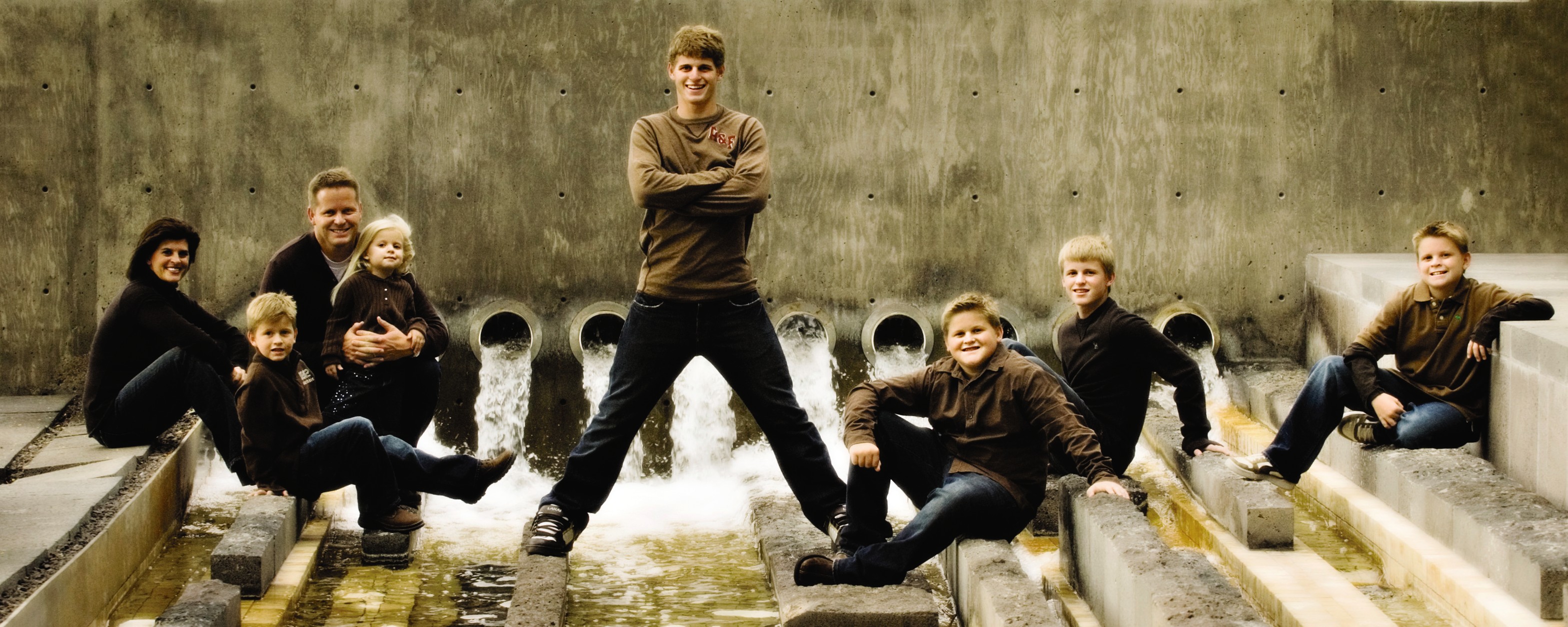
6-20
ABOUT THIS PHOTO Yes, all those kids belong to one family! The oldest boy is getting ready to leave home, so he is featured as the focal point of this image. Taken at ISO 400, f/5.6, and 1/160 second. ©Allison Tyler Jones / www.atjphoto.com
Lifestyle Photography
Lifestyle photography has greatly increased in popularity, and has some qualities of a photojournalistic style, giving photographs a more spontaneous, spirited, and unadulterated look and feeling. True photojournalists often act as a fly on the wall, observing and capturing what is happening before their lens for the purpose of telling the news. They don’t interfere with their subjects in any way.
Photographs are not set up, there is no wardrobe change or fixing of hair — the photo opportunity presents itself, and the moment is captured. Lifestyle photography is seldom romantic or timeless; it can be considered contemporary because it is fresh and of the moment.
Lifestyle photography borrows elements of true photojournalism with a few key differences. You might plan wardrobe and location, which is obviously not photojournalistic; however, once the setting is established and the subjects are in place, lifestyle photography requires you to get out of the way and let kids be kids. Forget posing or fixing hair as you go, just let them run and be ready with the camera.
Using your cell phone’s camera/video
One way to assure spontaneity and freedom while capturing your children and family is to take advantage of your handy cell phone camera, as in 6-21. These days it seems it will always be at your fingertips, but sometimes we forget we have it in moments that can slip by unrecorded.
Some photographers take this fun quite seriously and use creative apps, such as Hipstamatic, Photoshop, Colorsplash, BlendCam, TiltShiftMaker, and Vintage Video Maker, to enhance or embellish the images. Why not keep a journal on your cell phone using the camera, the video, and even the recording devices? That way you can document your family life. There are also apps that serve as actual journals for you to organize your moments methodically.
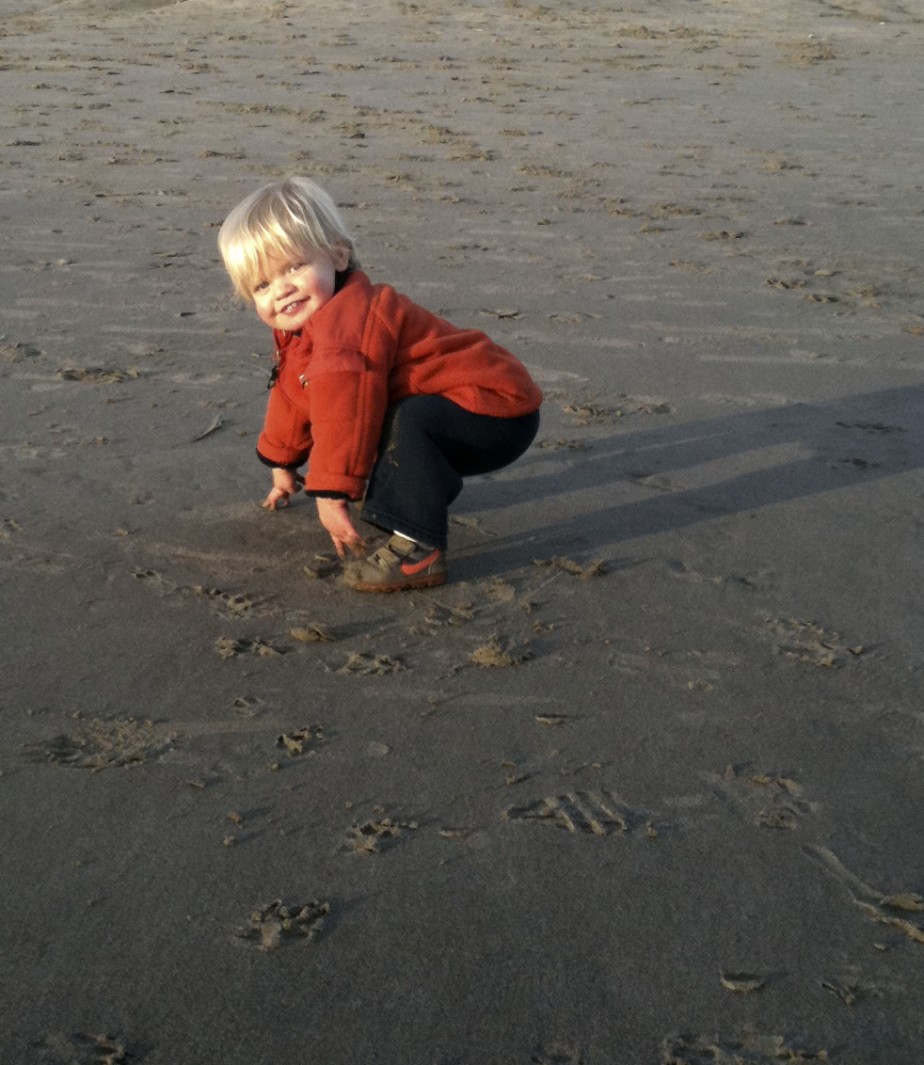
6-21
ABOUT THIS PHOTO The always improving quality of cell phone cameras and the spontaneity they afford you give you great opportunities to record precious moments like this one, late in the afternoon at the beach. I cropped it with the iPhone Photoshop Express App. Taken at ISO 70, f/2.8, and 1/180 second. ©Ginny Felch / www.photographingchildren.com
On location
As the family documentarian, it can be challenging to capture those spontaneous moments if your kids always want to pose for the camera. The best antidote to this is to keep your camera out and use it often. Before long, these creatures become accustomed to it and go about their business, allowing you to chronicle them in their natural habitat.
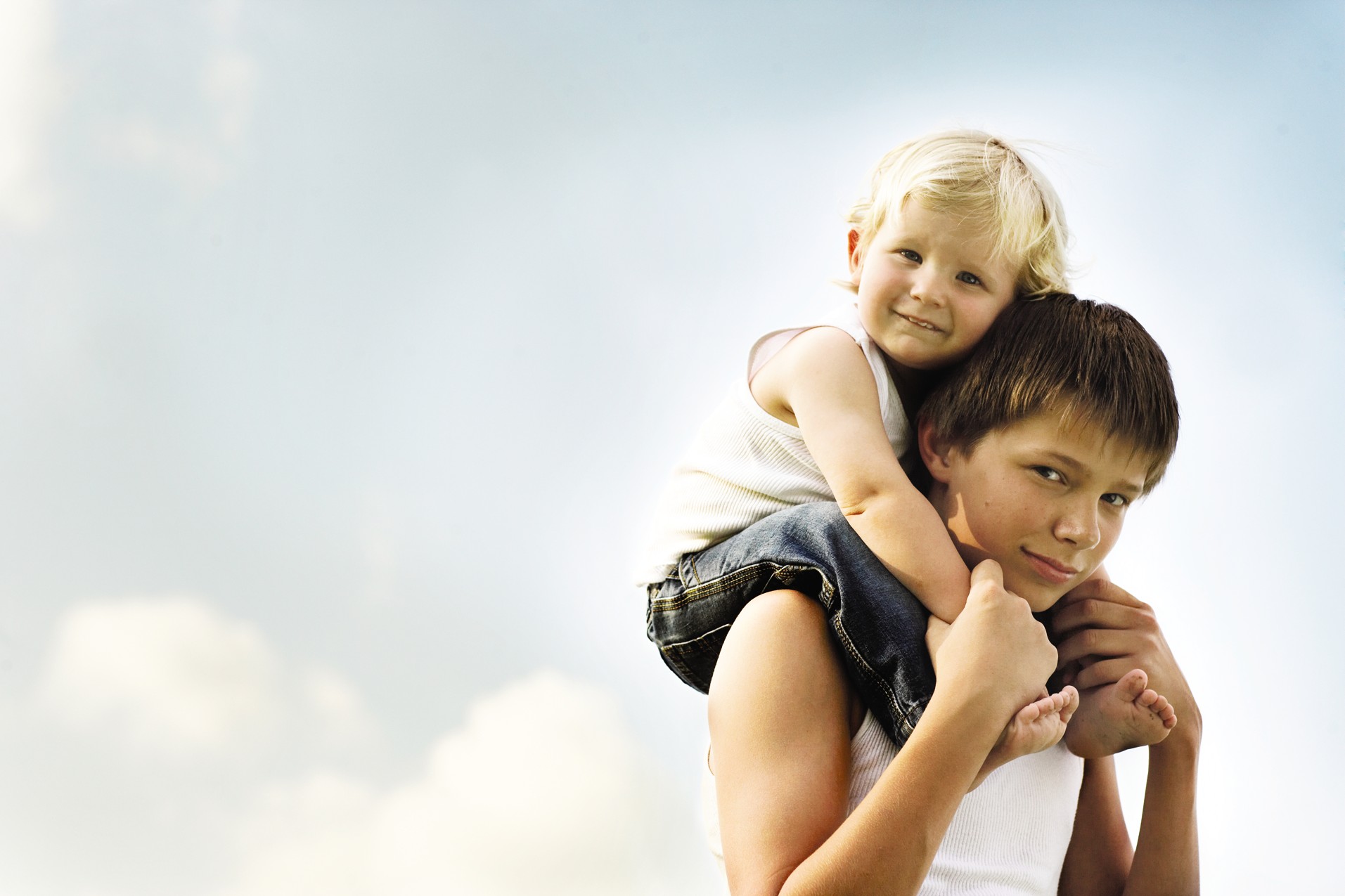
6-22
ABOUT THIS PHOTO The expressions on the faces of these siblings tell the story. The little girl adores her older brother, and he adores her but just doesn’t want to show it. Taken at ISO 200, f/4.5, and 1/1250 second. ©Jeffrey Woods / www.jwportraitlife.com
Telephoto or zoom lenses come in handy when you want to capture your photograph unobserved, as in 6-22 of a big brother giving a piggyback ride to a sibling. The longer lens allowed the photographer to get in close and simplify a cluttered background by focusing on just the subjects and a blue sky above.
Lenses and their various types are covered in depth in Chapter 9.
When striving to attain a lifestyle approach, you will want to capture the kids wherever they are, whatever they are doing. Can you imagine if the photographer had waited to shoot until the little girl in 6-23 was sitting up straight in her chair?
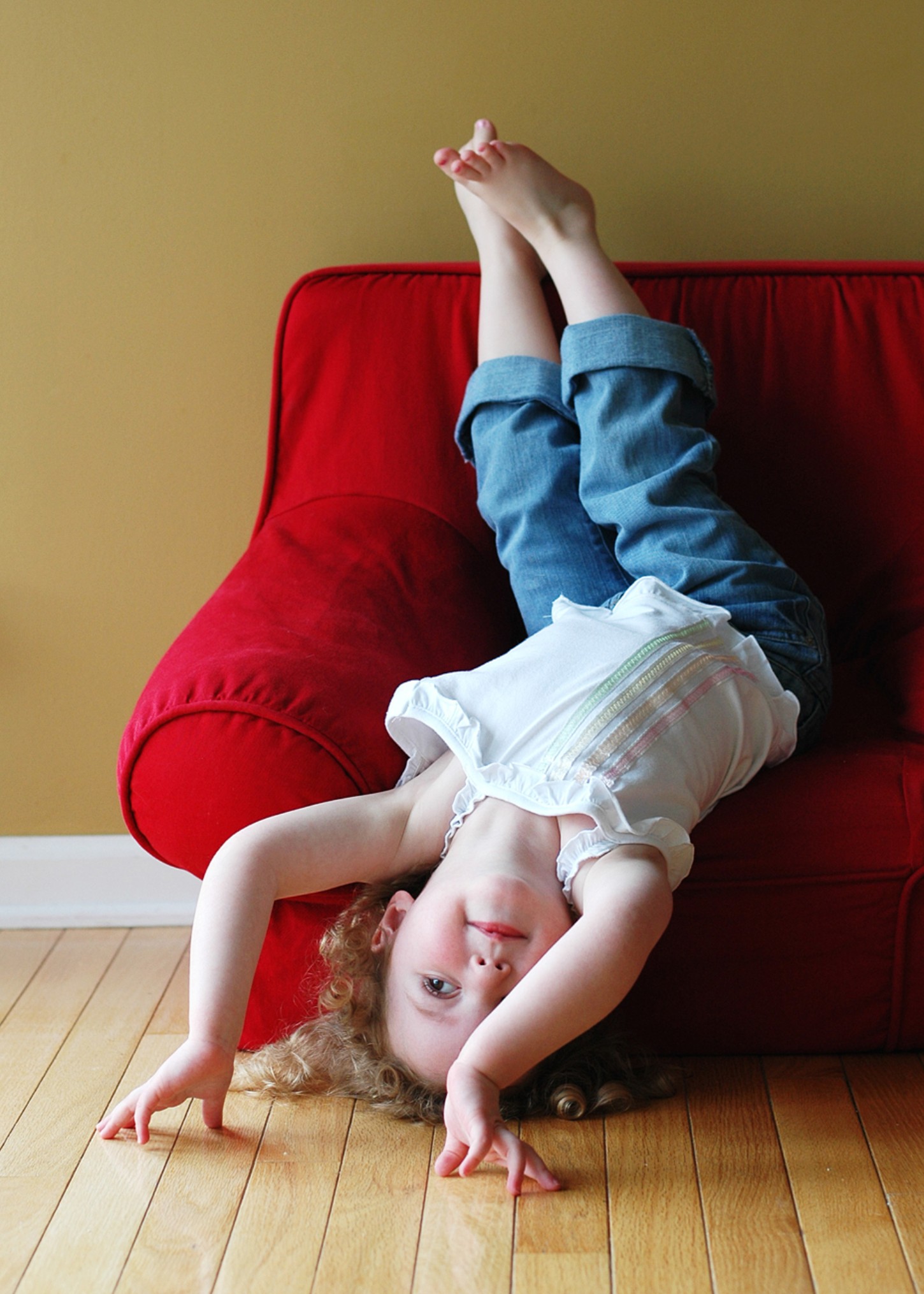
6-23
ABOUT THIS PHOTO This photograph gives a great sense of this little girl’s personality. Taken at ISO 400, f/2.8, and 1/160 second. ©Stacy Wasmuth / www.bluecandyphotography.com
Photographing children in their natural environment allows them to be more comfortable, and the images have the added value of triggering memories later in life of their childhood home. With the parents’ cooperation, roam around in the home to find ideal or unusual settings and light to add pizzazz to your photos, as in 6-24, 6-25, and 6-26.

6-24
ABOUT THIS PHOTO Years from now, this photo will be a reminder of the home where this boy grew up. The natural and comfortable demeanor he shows while reading suggests that the photographer did not interfere or pose him. Taken at ISO 1600, f/1.8, and 1/400 second. ©Doreen Kilfeather / www.dkilfeatherphotography.com.
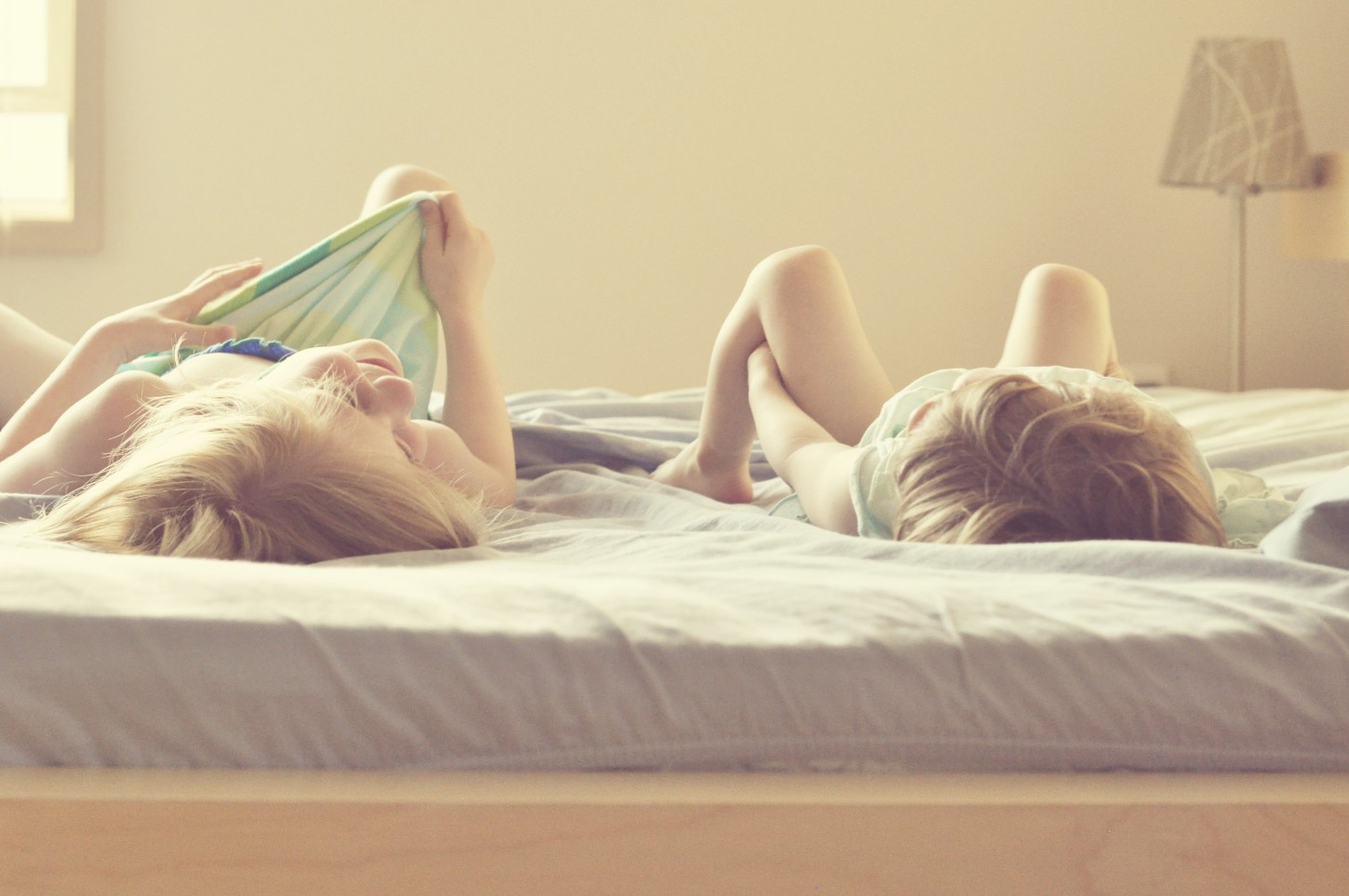
6-25
ABOUT THESE PHOTOS Kids love to show off their bedrooms, which, in turn, conveys part of their personality. These playful and casual girls just exude comfort as they spend some afternoon time chatting away. The soft pastels and window light, as well as the photographer’s post-production skills, tie it all together. Taken at ISO 1250, f/4.5, and 1/80 second. ©Valeria Spring / www.theredballoonphotography.com
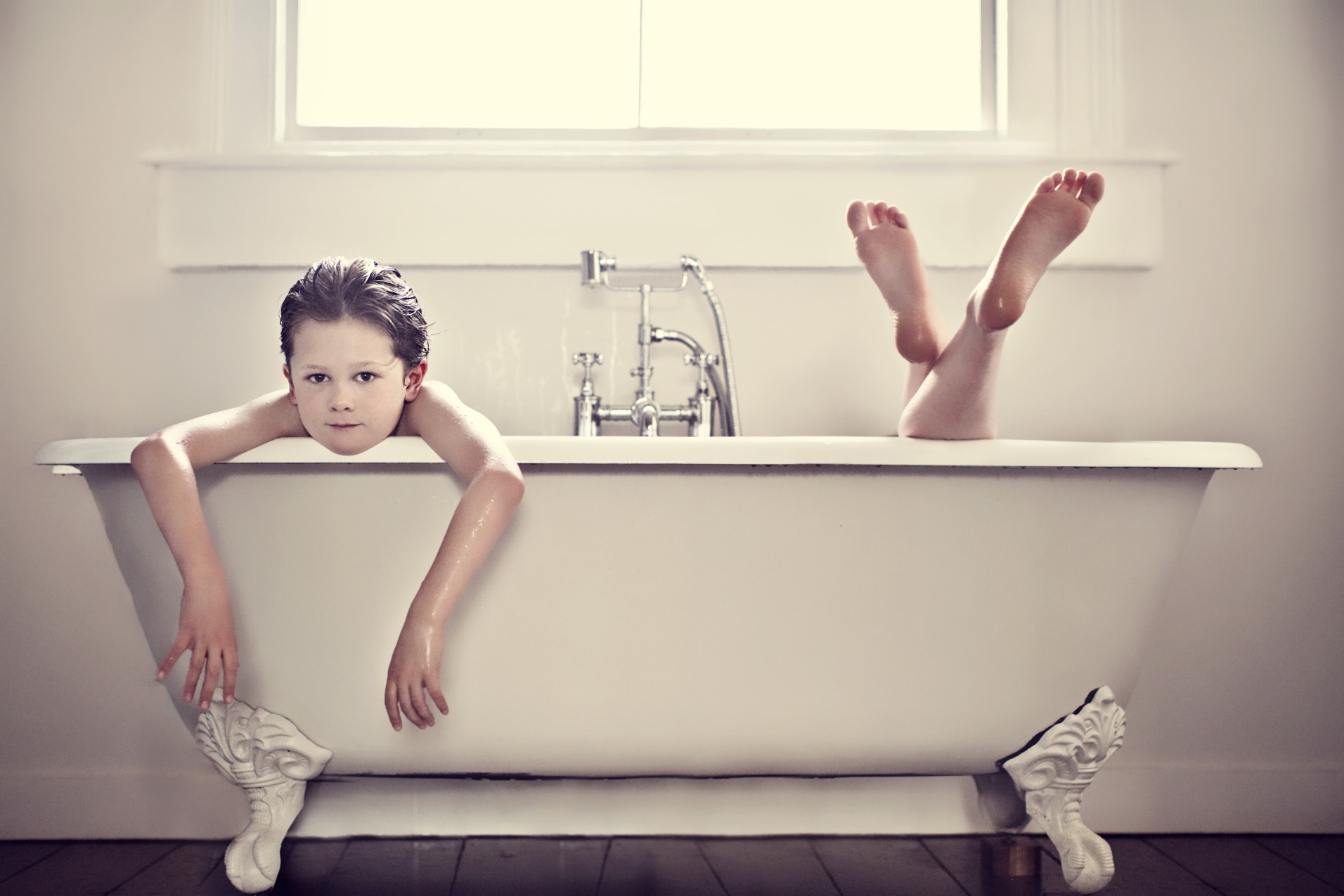
6-26
ABOUT THIS PHOTO Often times, the family bathroom has some of the best light and reflection in the house. Using it as your location can add fun to the experience and result in a surprising and extraordinary image. Taken at ISO 1000, f/2.2, and 1/60 second. ©Doreen Kilfeather / www.dkilfeatherphotography.com
Mood
It’s not very realistic to think that you will just happen upon amazing moments and capture them. Sometimes that happens, but most times, it doesn’t. That’s where a little assisted reality comes in. Put the kids in their environment and then let them have fun. For example, the little boy in 6-27 was easily entertained playing superman on the living room couch. Using available window light helped to give the photographer enough light to catch the action with a fast shutter speed. Giving a child the opportunity to play his favorite everyday games can really enhance the mood and feeling of a photograph.
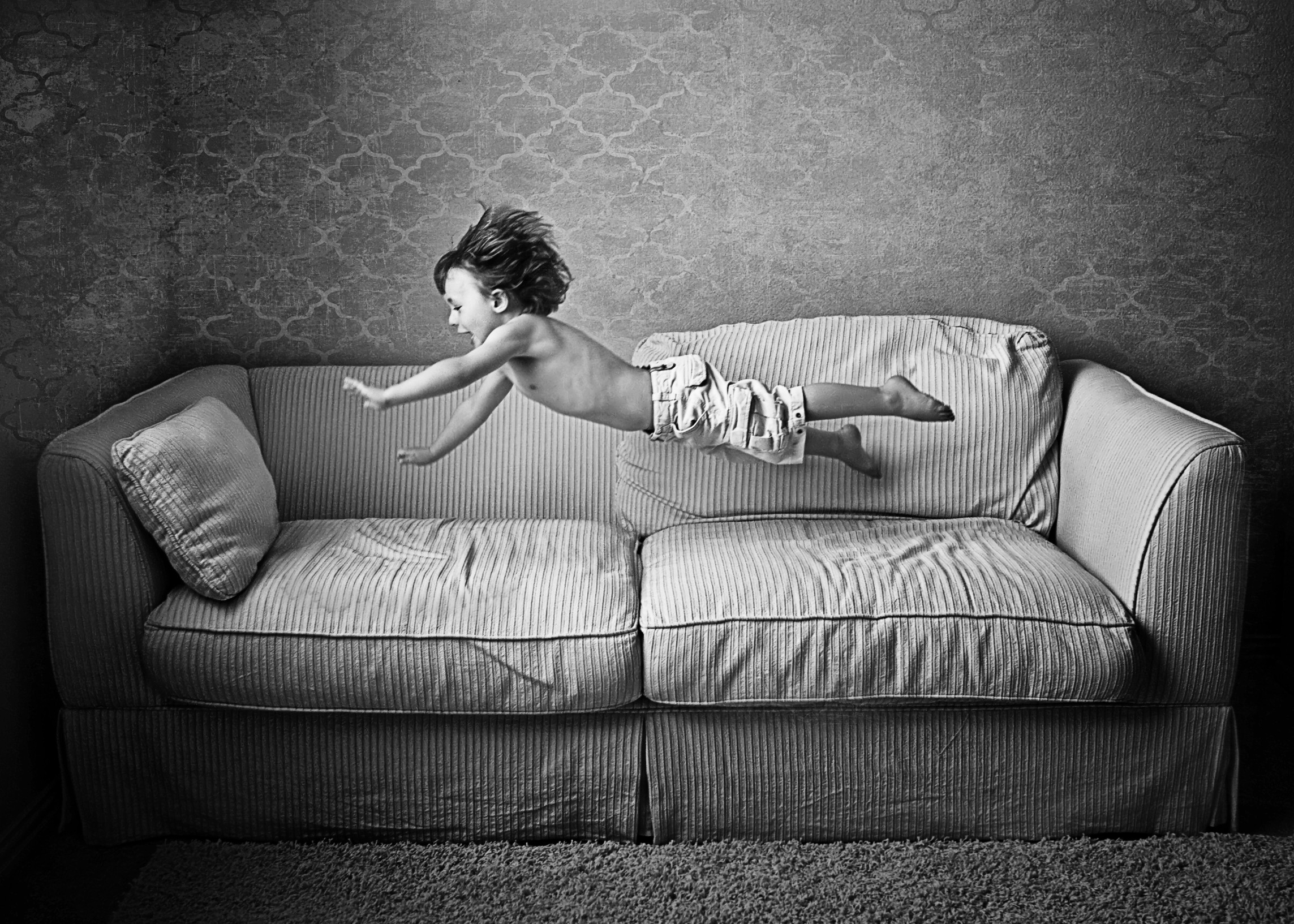
6-27
ABOUT THIS PHOTO Everyday play, and perhaps a little more permission than usual, adds to the excitement of creating a lifestyle photograph. This photograph is robust with energy from a very energetic boy, and is brought to life even more with the dynamic lighting and composition. Taken at ISO 640, f/2.8, and 1/500 second. ©Mary Schannen / www.melangephoto.com
A foggy beach day highlights the family in 6-28 as they cavort in front of the cave on the Oregon coast. The clothes and setting and lighting were all planned, but the fun and emotion are the real deal.
Another way to portray siblings is by focusing in on only a part of them, as in 6-29. Placing the children on the mom and dad’s bed in their light-filled bedroom allows for a new take on a traditional portrait.
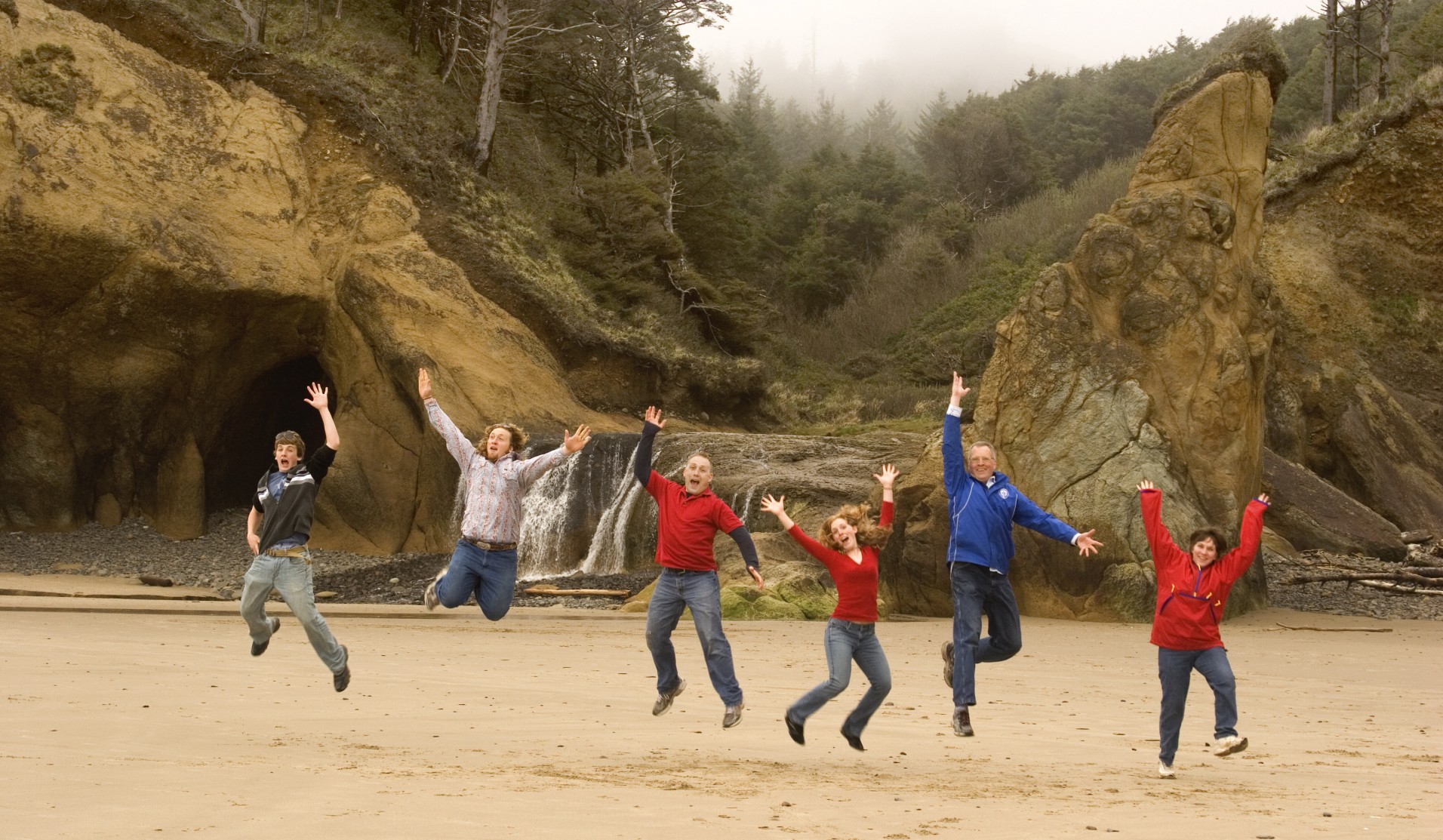
6-28
ABOUT THIS PHOTO Finding the right lighting and setting allows the family to be spontaneous and free in their expressions and actions. Taken at ISO 125, f/3.2, and 1/640 second. ©Linda Lapp Murray
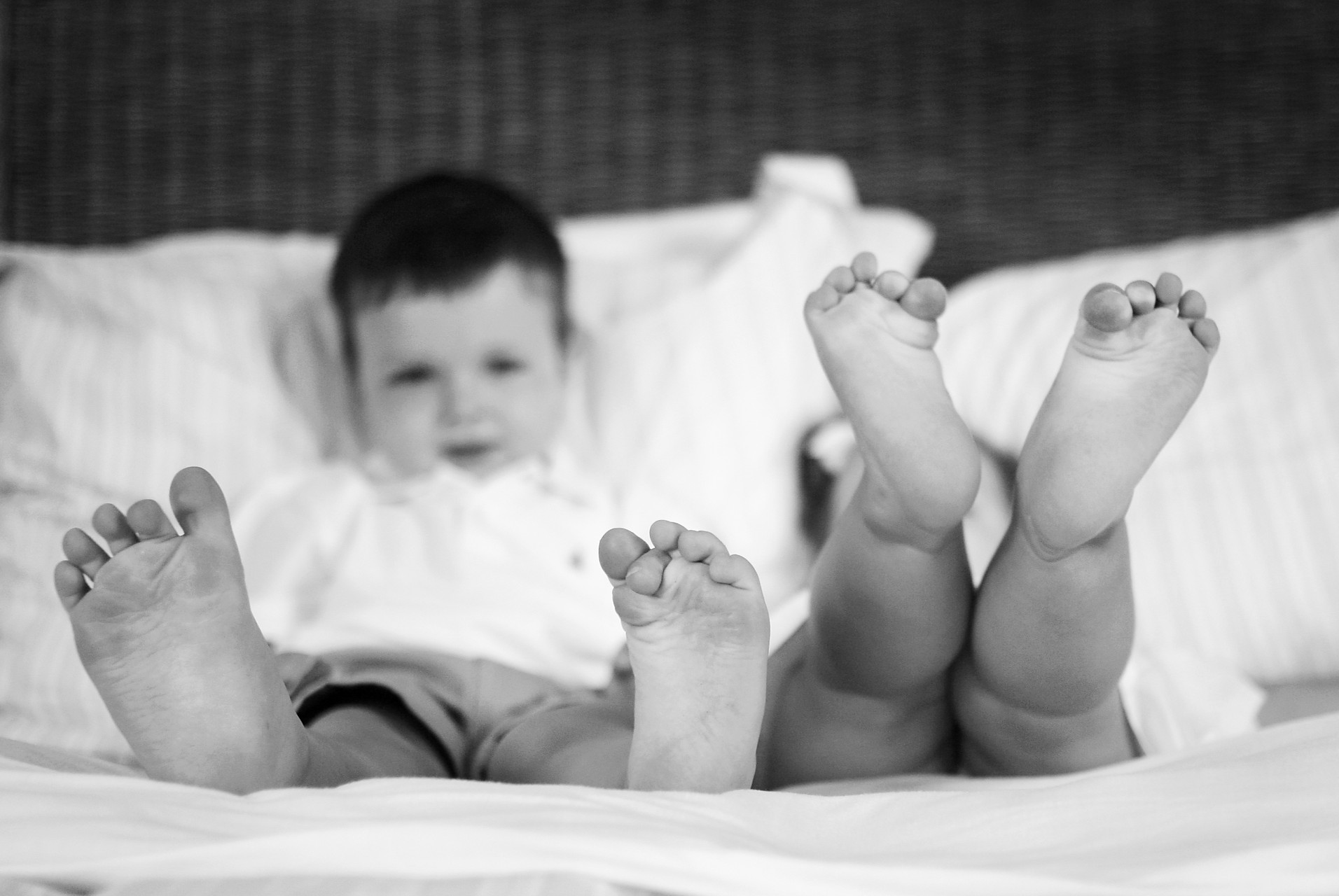
6-29
ABOUT THIS PHOTO This portrait is fun and definitely creative, telling a story about a lifestyle. The simple background and horizontal lineup make a strong composition. Taken at ISO 500, f/2.0, and 1/100second. ©Jen Sherrick / www.jensherrickphotography.com
Cropping in tight to capture the child sharing a mischievous grin while enjoying his snack creates an instant connection with the viewer, as in 6-30.
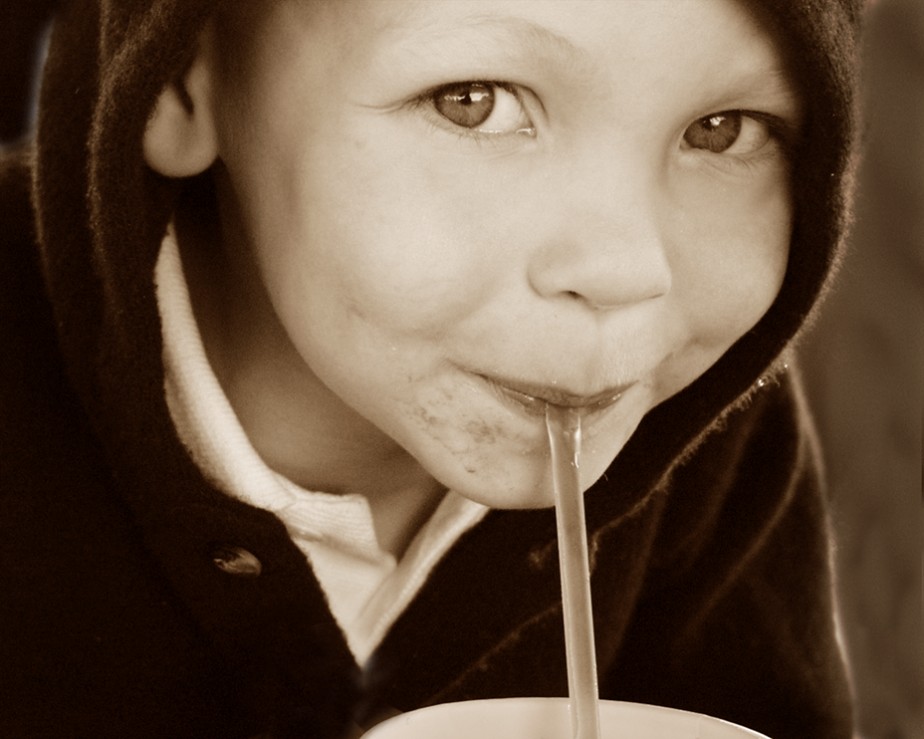
6-30
ABOUT THIS PHOTO I captured this elfin smile on a ferry with my nephew, and it is emphasized by cropping in close. The darker tones surrounding his face draw your eyes to the place of interest. Taken at ISO 500, f/4, and 1/125 second. ©Ginny Felch / www.photographingchildren.com
Preparing Parents for Their Child’s Portrait
Whether you are photographing children as a hobby, a passion, or as a career, communicating with the parents of your subjects is an important part of creating a unique and meaningful portrait. Ultimately, your portraits contain a large part of you and your vision, even when you are following parents’ wishes. If you are interested in developing your photography as a vocation, both your images and your business will reap the benefits of collaboration and communication.
“In the faces of children I have seen a look of wisdom and of kindness expressed with such ease and such certainty that I know it was the expression of the whole race.” ~Robert Henri
Outlining expectations
It is a good idea to give the parents some idea of what your expectations are for photo sessions. Many professional photographers reveal their philosophy and working style as well as clothing suggestions and other important information on their websites or brochures. Take the time to get an idea of what the parents’ goal is for the final result of the photo session. For example, do they want a large wall portrait or just a couple of shots for the annual Christmas card?
This kind of communication works to establish trust in you as an artist and respect for your time and opinions. The clarity of the information up front prevents miscommunication and misunderstandings later. Some photographers place their business forms and policies online, which helps avoid costly and timely mistakes.
The most important thing you can do to prepare parents for an upcoming portrait session is to ask them to play the session down when speaking with their child. Children should come into your time together without feeling the pressure of any expectations. Many of the photographs in this book may look as though the children were perfectly behaved and everything was going according to some master plan, but nothing could be further from the truth.
Everything that you plan and discuss ahead of time is valuable and helpful in order to make a meaningful children’s photograph. However, when you work with the highly unpredictable nature of children and weather, both you and the parents need to let go of the exact results.
More often, if both parties (parents and photographer) are savvy to this, photographs are likely turn out better than expected. Surprises that come along won’t be frustrating, but creatively challenging.
“In order to be a portrait, the photography must capture the essence of its subject. Herein lies the main objective of portraiture and also its main difficulty. The photographer probes for the innermost — the lens sees only the surface.” ~Philippe Halsman
Collaborating with parents
Many child photographers prefer to work with the children they photograph one-on-one, with the parent off to one side or in another room completely. One of the main reasons parents want to remain with the child and photographer is that they want to make sure that the children don’t exhibit their funny smiles, their little quirks, and so on. The irony is that when the children are separate from parents, these expressions rarely occur. If the parents still insist on being present during a session, you might ask that they stand back, watch quietly for awhile, and perhaps walk away for 45 minutes if they feel comfortable doing so.
Tell the parents that you take pride in evoking expressions from the children, and that is usually possible only without distractions. If you are photographing outside, allow the child to be quiet and listen to the surroundings. Bring the silence to their attention and ask them what they hear. These quiet moments can evoke wonderful, natural, whimsical expressions, as in 6-31. Evoking these moments requires uninterrupted time between photographer and child.
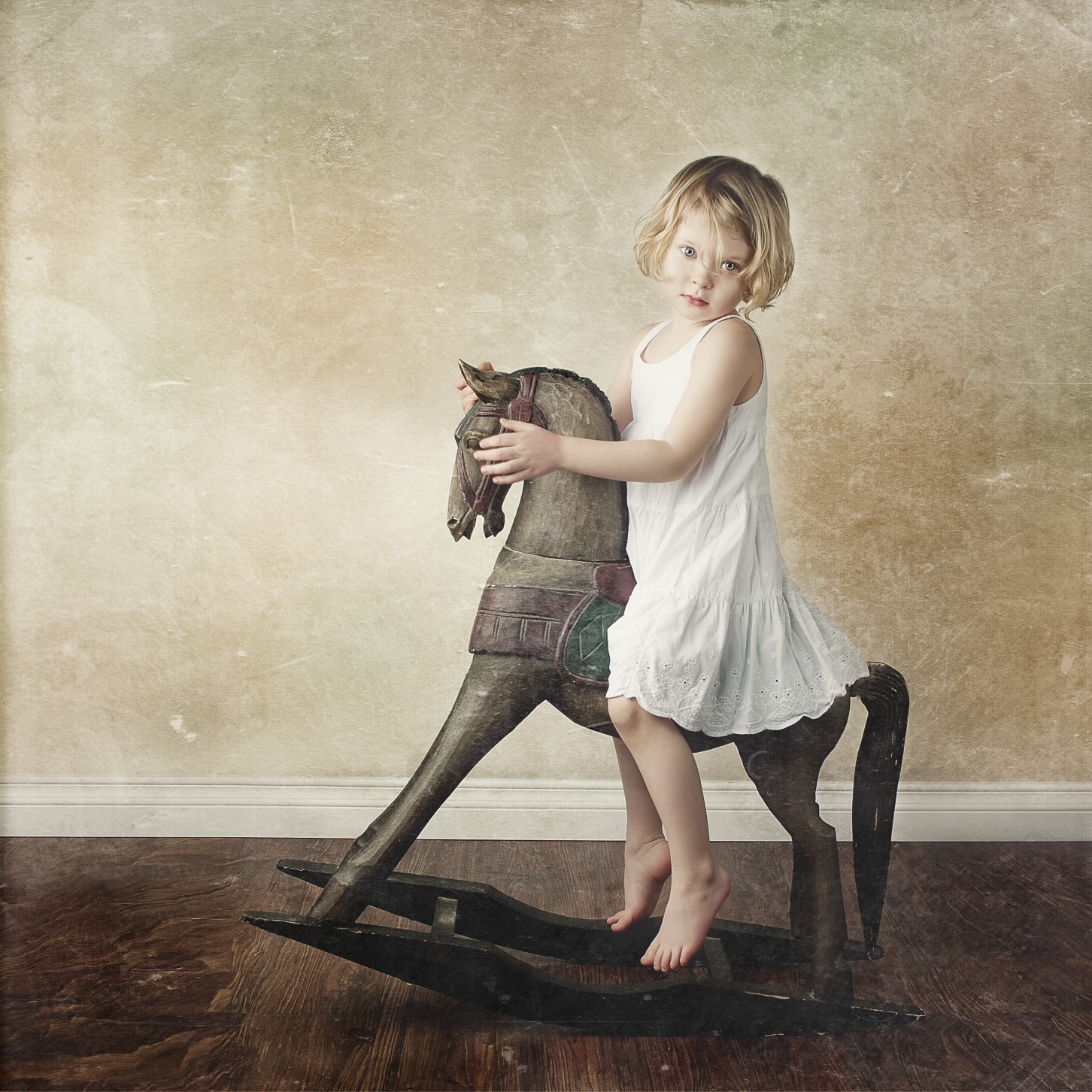
6-31
ABOUT THIS PHOTO Riding on her old-fashioned rocking horse seems to have evoked memories or fantasies for this little girl, as her expression is far-off and other-worldly. These expressions can only happen when the photographer establishes trust and comfort. The photographer used her own texture and actions in post-production. Taken at ISO 200, f/5.6, and 1/250 second. ©Annie Manning / www.paintthemoon.net
Leave the big, cheesy smiles to the school photographers. If there is a smile or a hint of sweetness, let it be a reaction to something you have said. If you must work with an assistant, which is helpful if there are two or three young children, ask him or her not to distract from the relationship unless requested.
Ask the parents not to prime their kids about smiling or to discuss behavior issues. You should expect children to be children, and the more relaxed and happy they are as they enter the session, the better it all works for everyone. Parents should also try to be relaxed and confident because they can influence the attitude of their children. Tell them they are going to have fun with the photographer, but don’t ever fib about what is coming up.
If parents convey confidence and make very little fuss about bringing their kids to you, they can set the tone for the entire session. Always do your best to distract the children during those potentially tender moments.
If you choose to make a career of children’s photography, you will experience a wide array of behavior from very good to downright horrible. That’s what makes it challenging, fun, and creative for those who love children.
Some children are soothed by having a creature comfort along with them. You might suggest in your communication with parents that they can bring along a blanket, stuffed animal, or favorite toy. Special treats can also be a good idea (always check with parents first). You can offer them during the session, as long as they aren’t too messy.
Keep photographing
Inevitably, when you think the session is complete and it’s time to pack up and go, something surprising and photo-worthy will happen (as in 6-32), and you won’t have your camera in hand. Make it a practice not to put your camera away until you are in your car ready to leave. Moments like this cannot be re-created, no matter how hard you try!
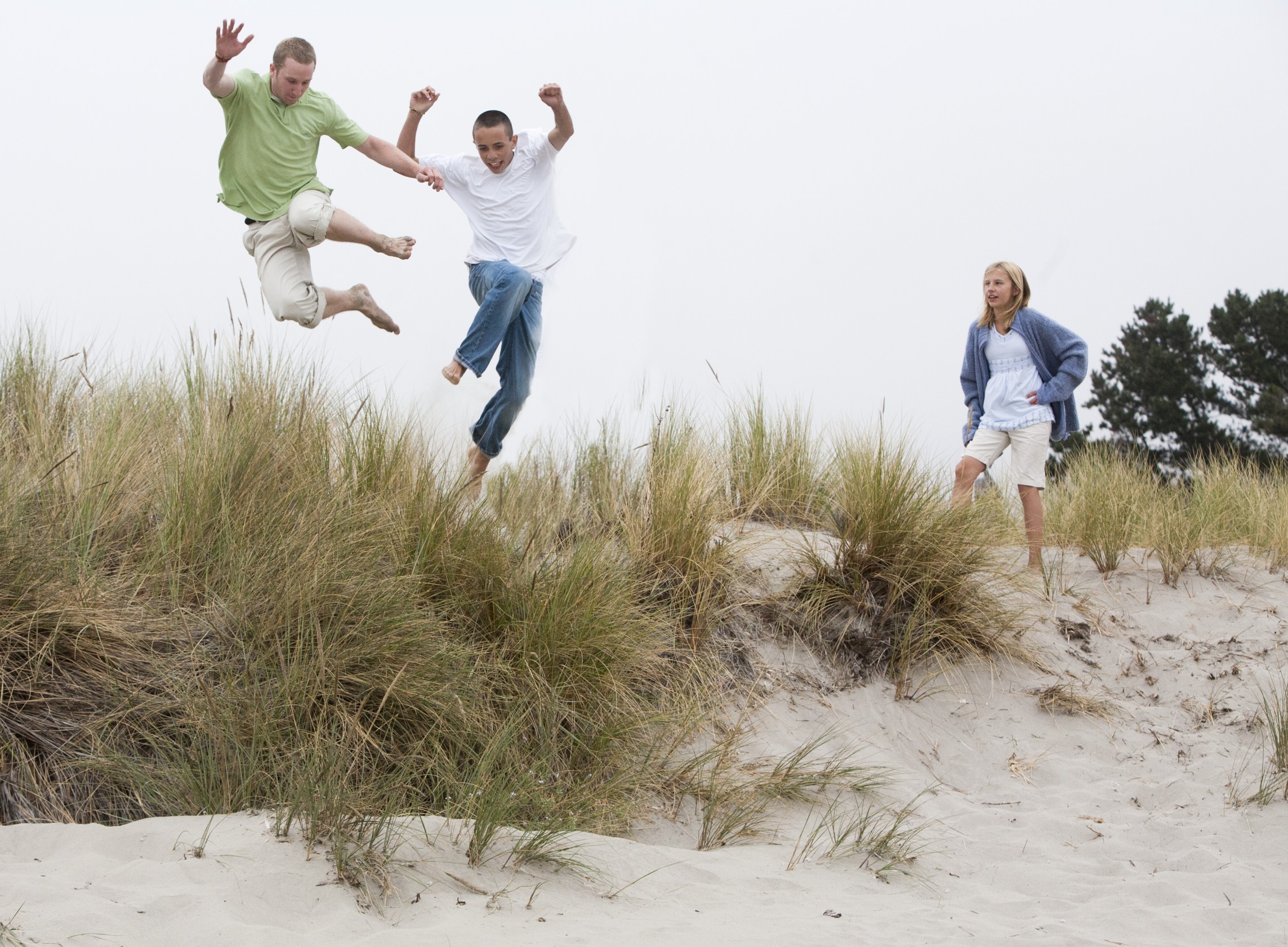
6-32
ABOUT THIS PHOTO As soon as the extended family portrait was completed, the teens broke out into acrobatics on the sand dunes in celebration. Fortunately, I had not put away my equipment! Taken at ISO 1600, f/7.1, and 1/400 second. ©Ginny Felch / www.photographingchildren.com
Portrait Planning
Sometimes you will be creating individual portraits as well as family portraits. Ask parents to decide beforehand which is more important to them. Try not to go beyond the comfort zone and attention span of the children. That can be a brief period, depending on the ages of the child or children. Better to start off with individual portraits and move on to the groups if time and temperament permit. If you, or the family, prefer the family portrait, do that first.
Many people want to have more natural and un-posed photographs. Of course, the more people you have in a portrait, the more posed it tends to be as you try to corral everyone into the frame, unless you have the luxury of scheduling a session during a more natural event (family reunion or picnic). Be sure to communicate that knowledge with parents so they are prepared to see less spontaneity when there are more people in the photograph.
Assignment
Create a Special Portrait
Ask friends with a child if you can create a portrait for them. Communicate your desire to make a special portrait and collaborate with them, with you as their guide. Use the information you learned in this chapter. Post your best image of the child.
I wanted to capture a very special and close relationship between a boy and his cherished puppies, so I chose to crop in tightly to give it an intimate and contemporary feeling. Taken at ISO 500, f/5.0, and 1/100 second.
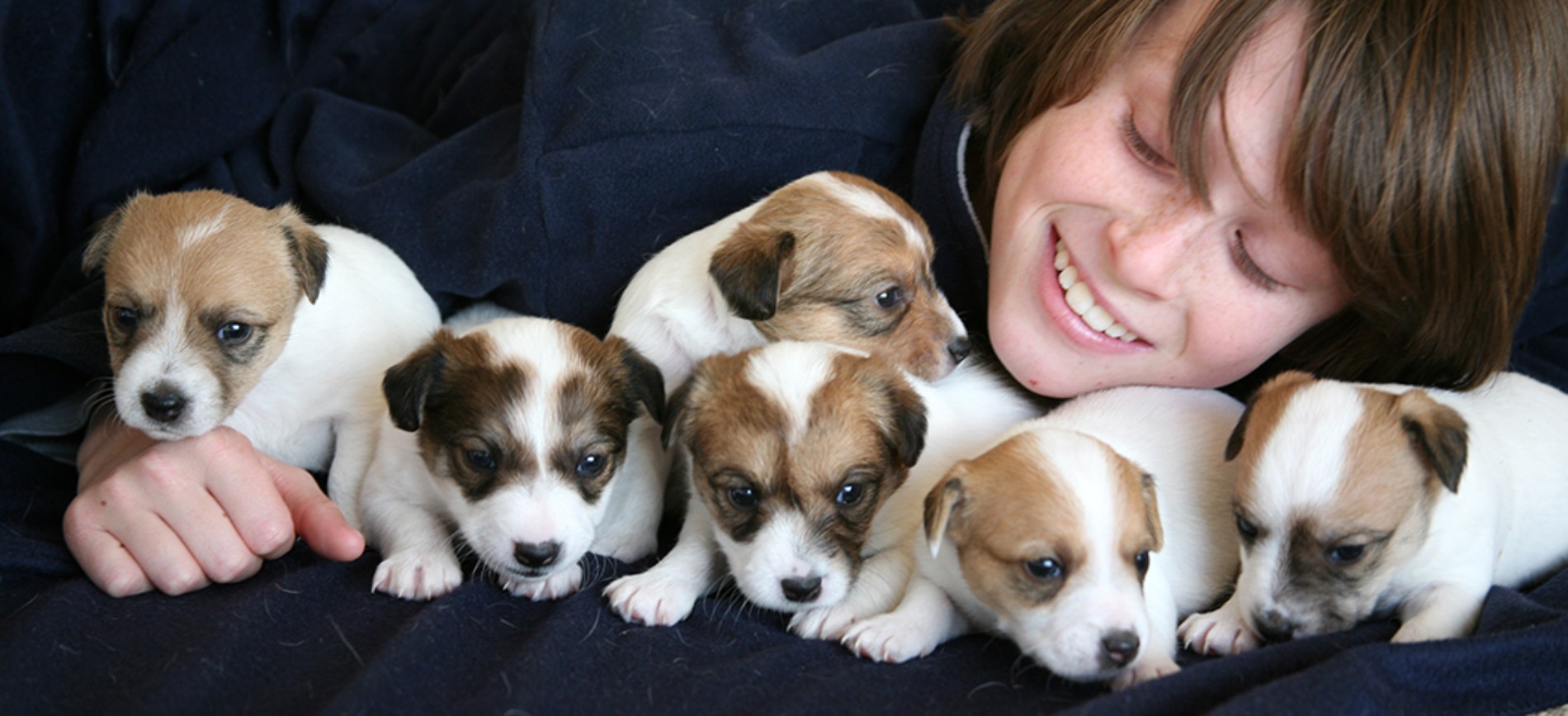
©Ginny Felch / www.photographingchildren.com
Remember to visit www.pwsbooks.com after you complete this assignment and share your favorite photo! It’s a community of enthusiastic photographers and a great place to view what other readers have created. You can also post comments, read encouraging suggestions, and get feedback.
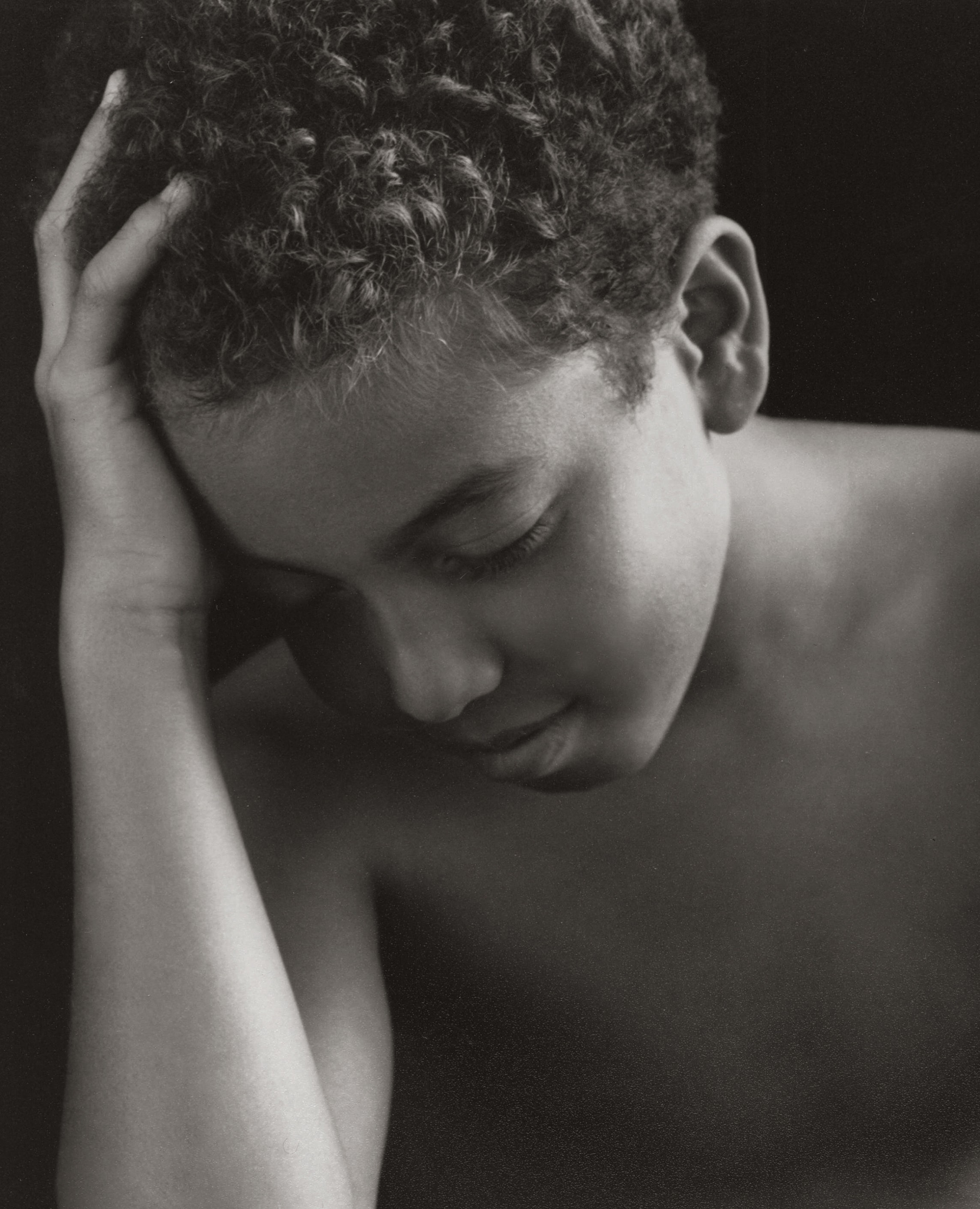
©Theresa Smerud / www.theresasmerud.com

